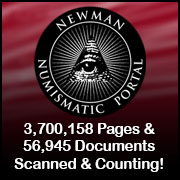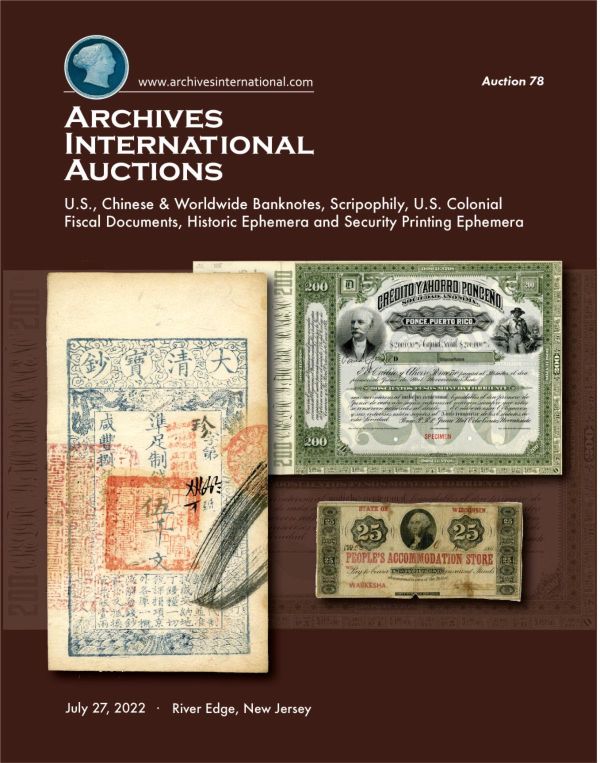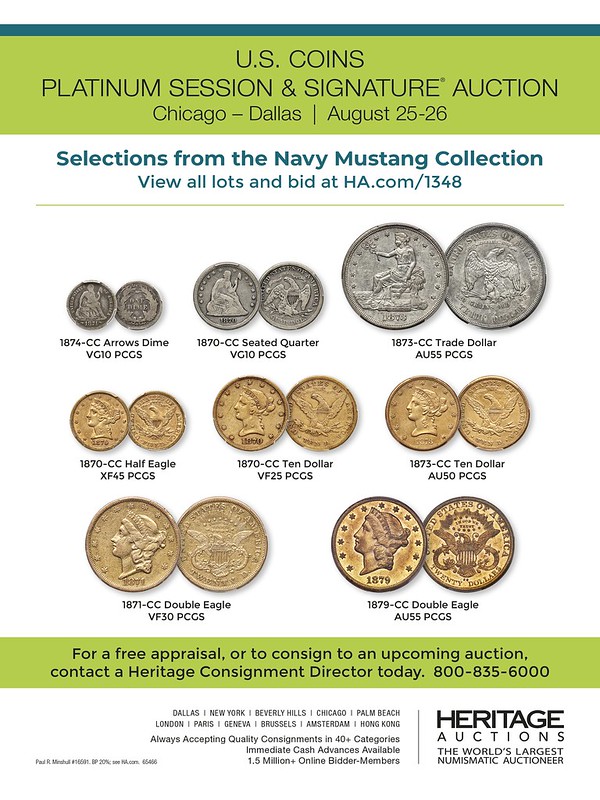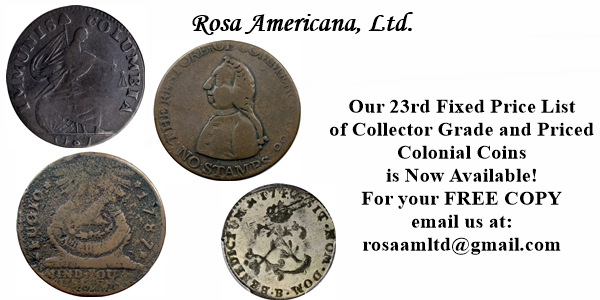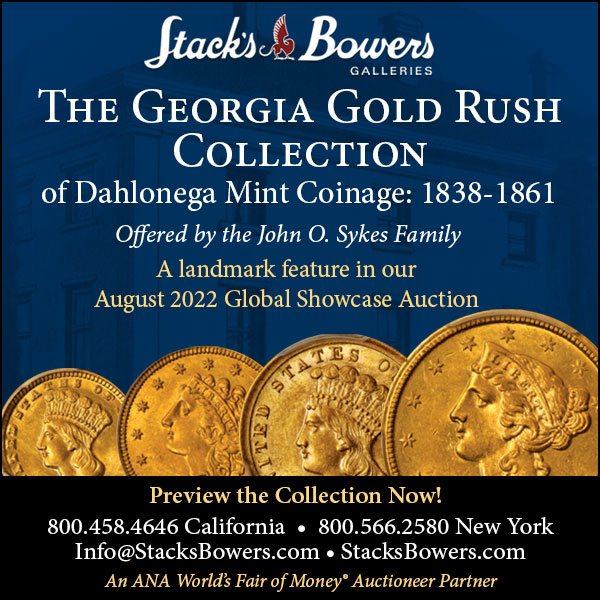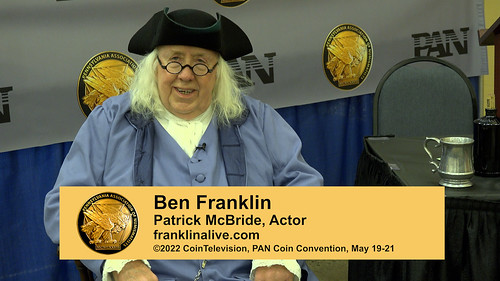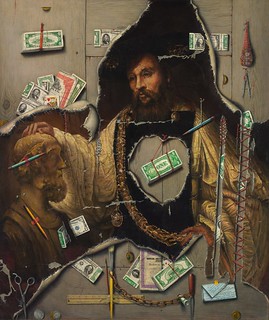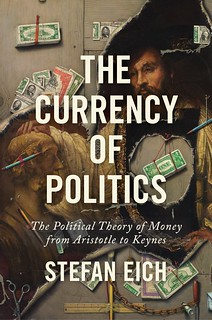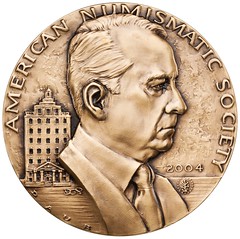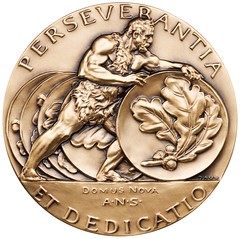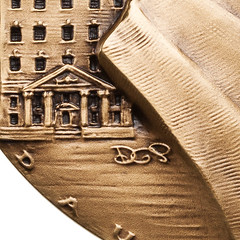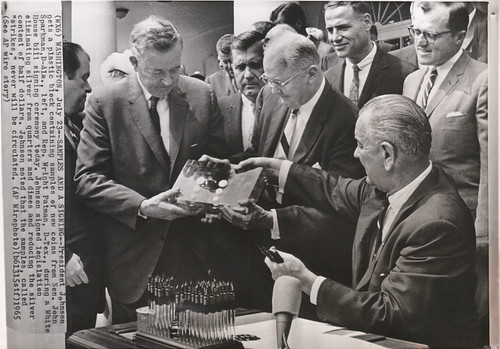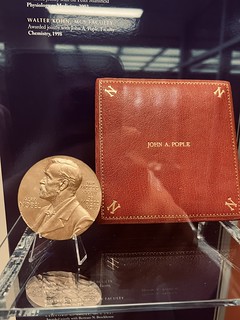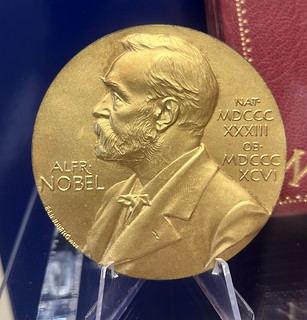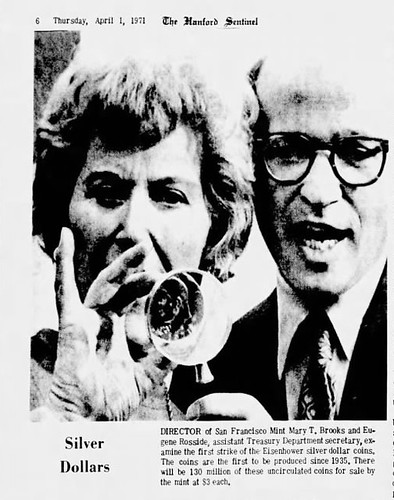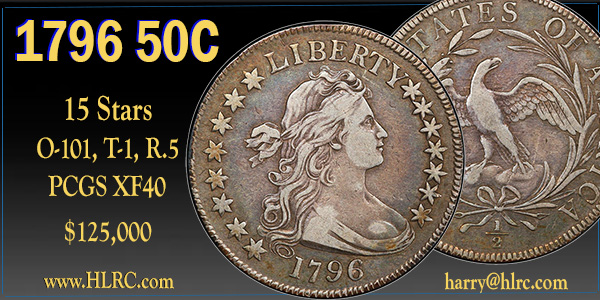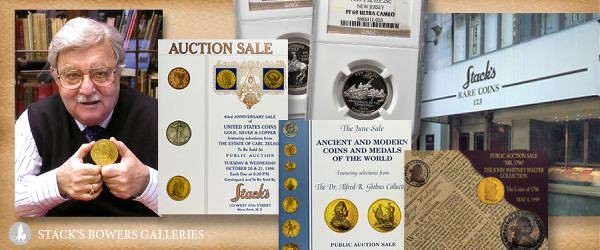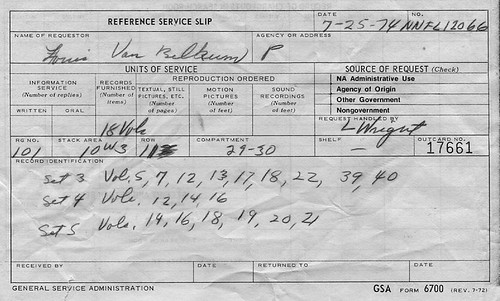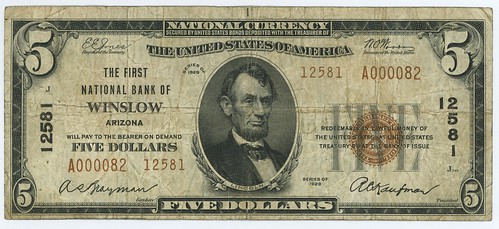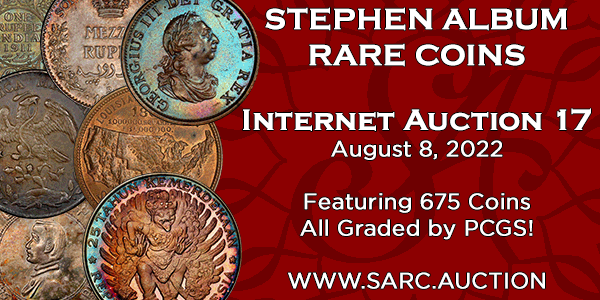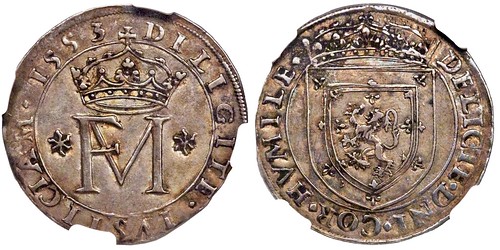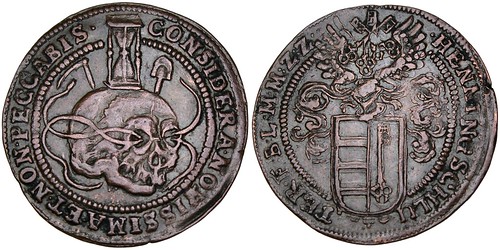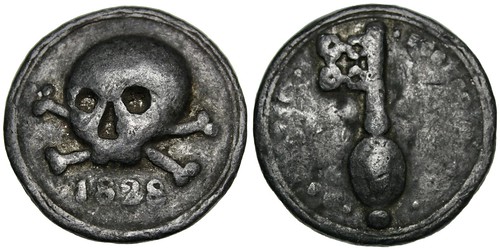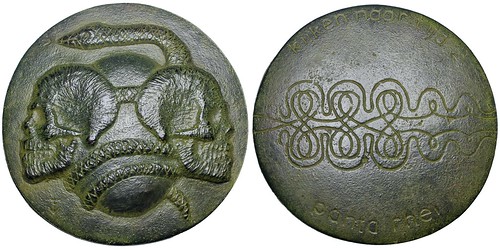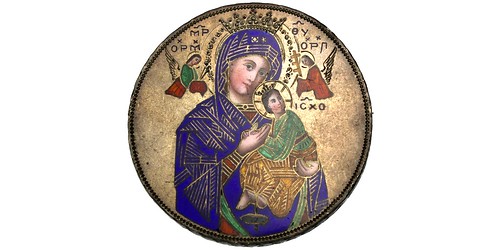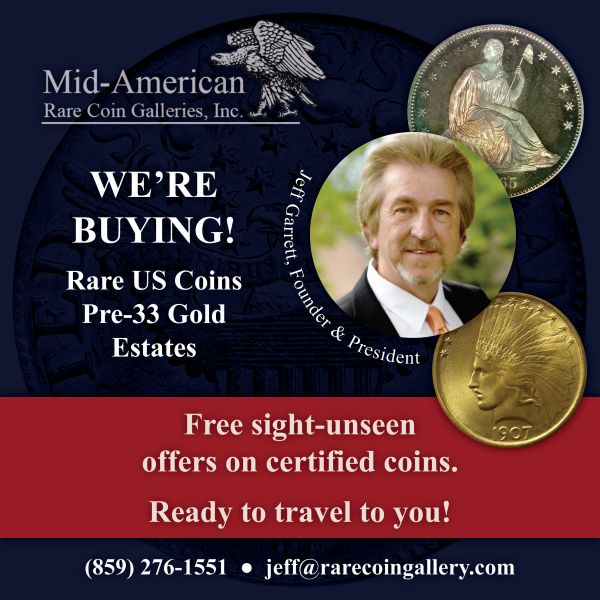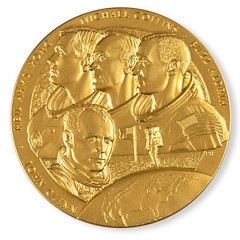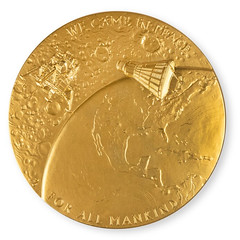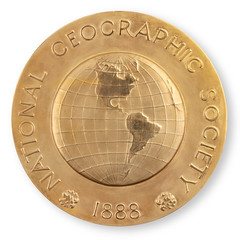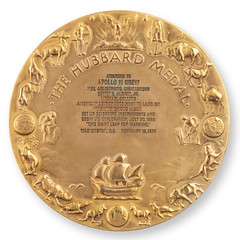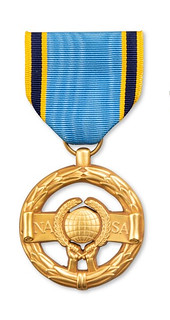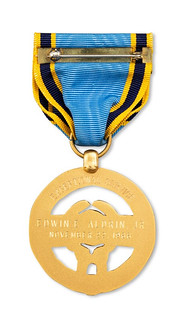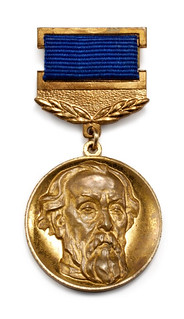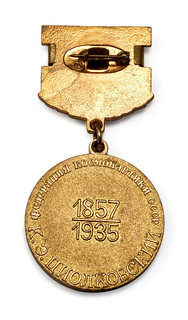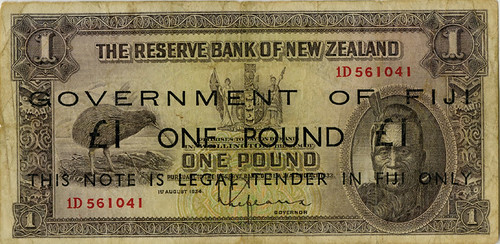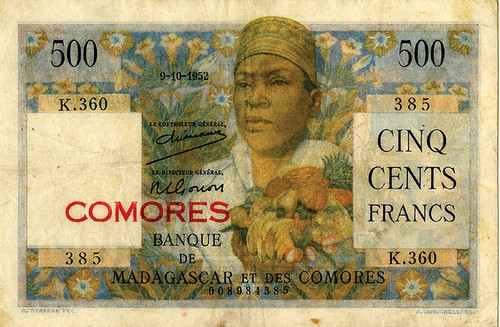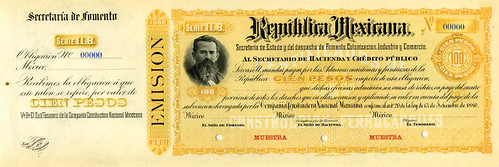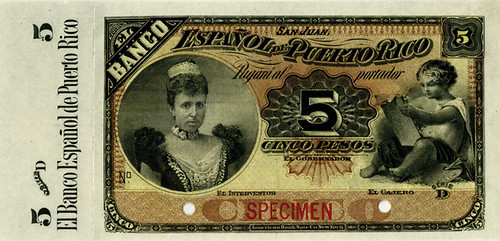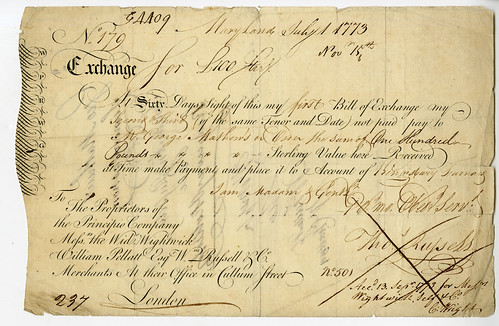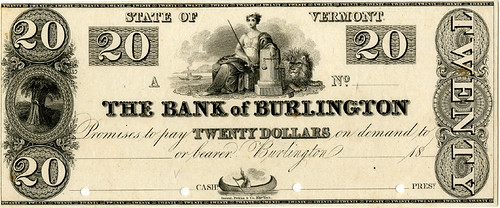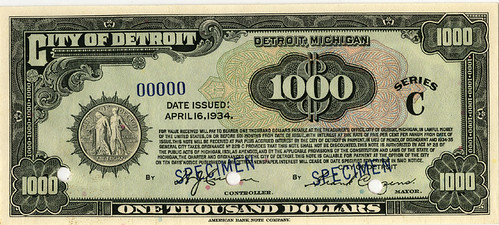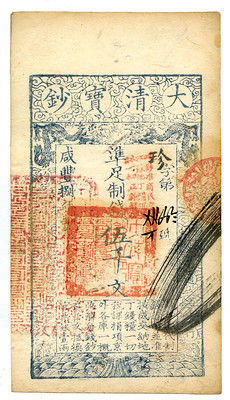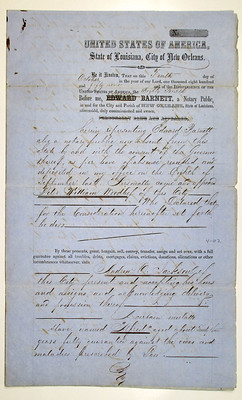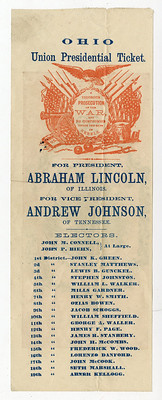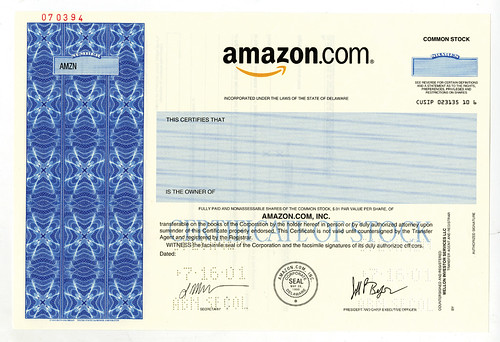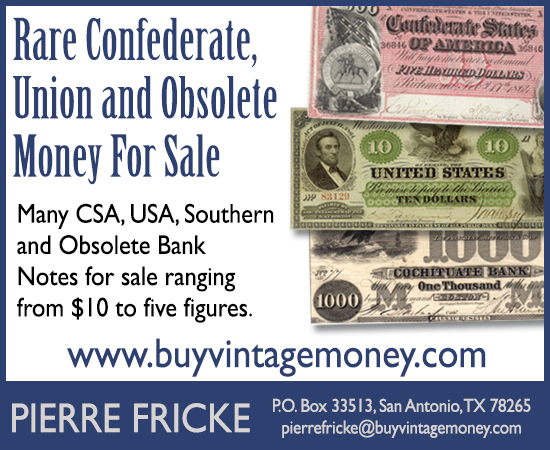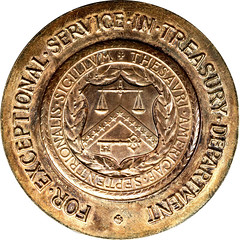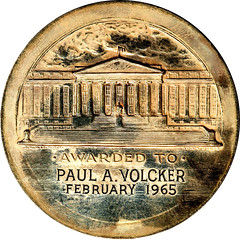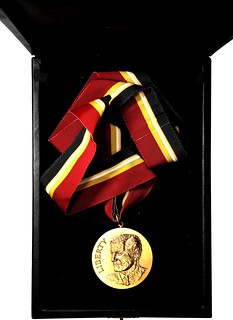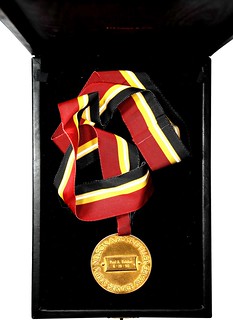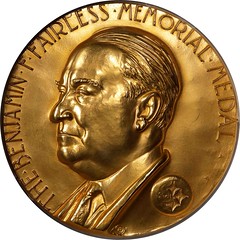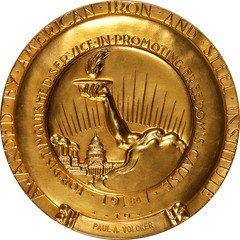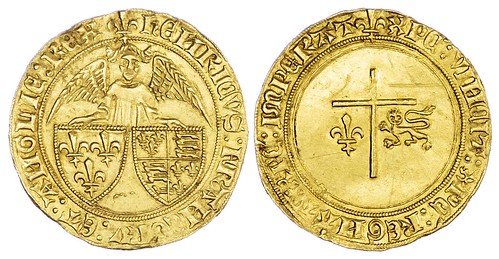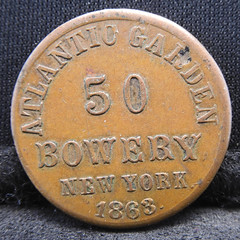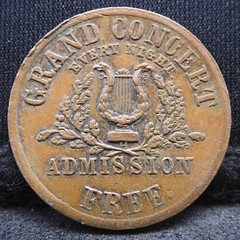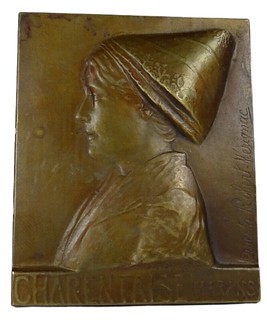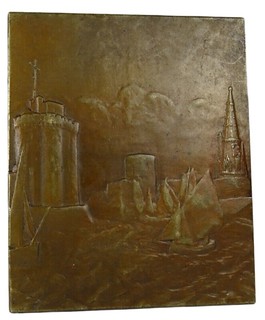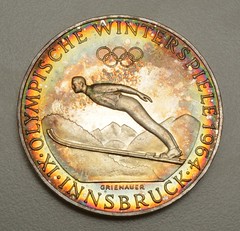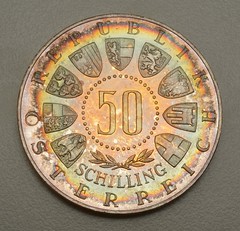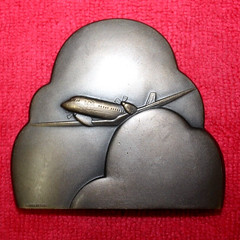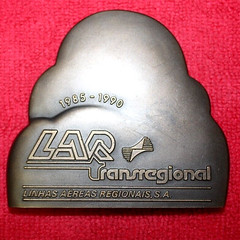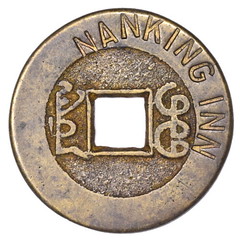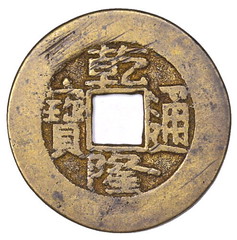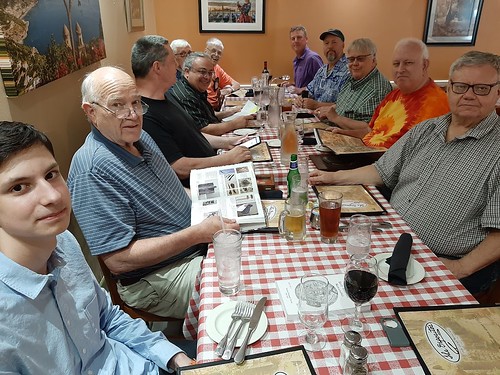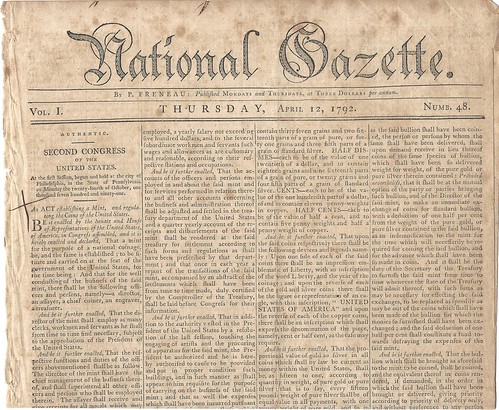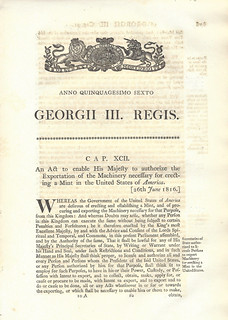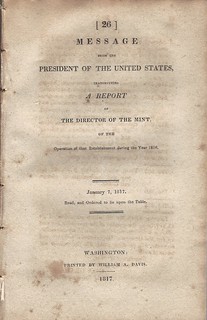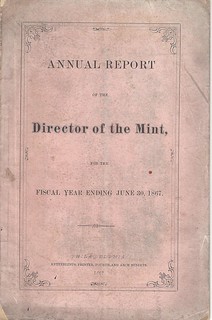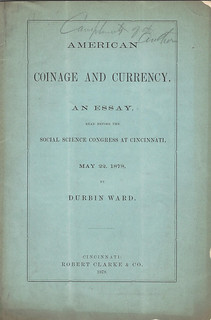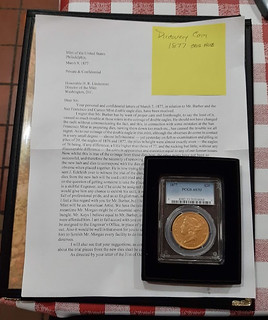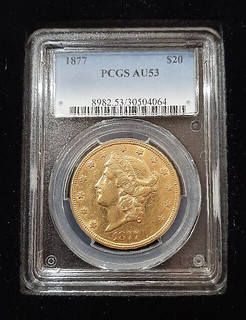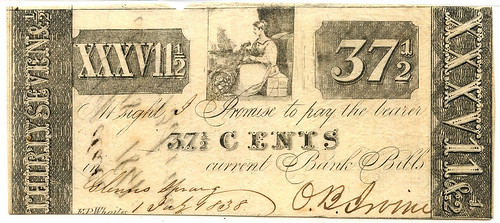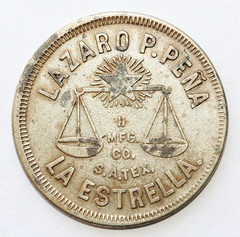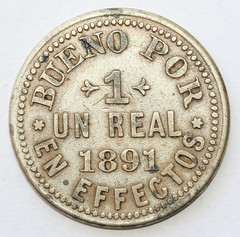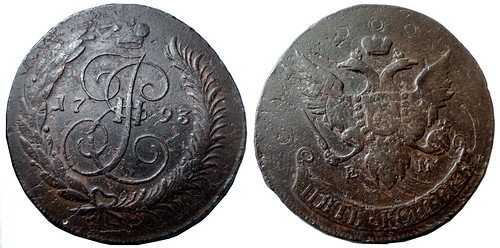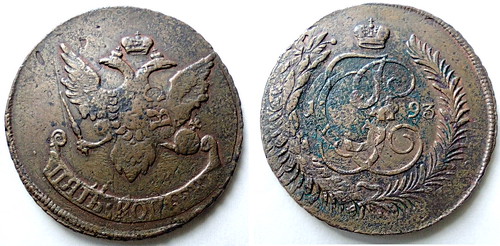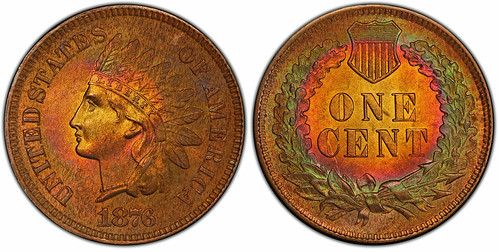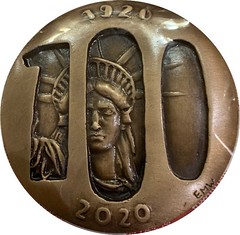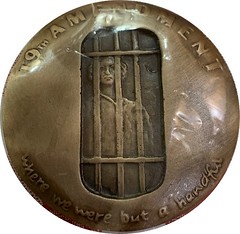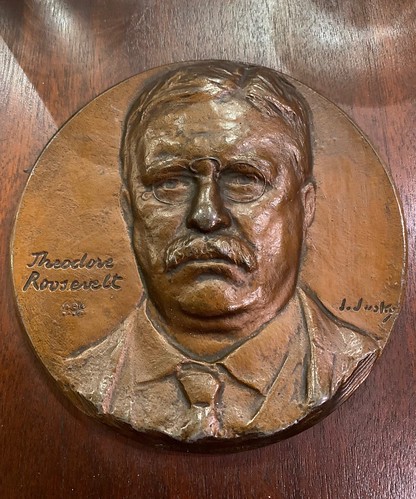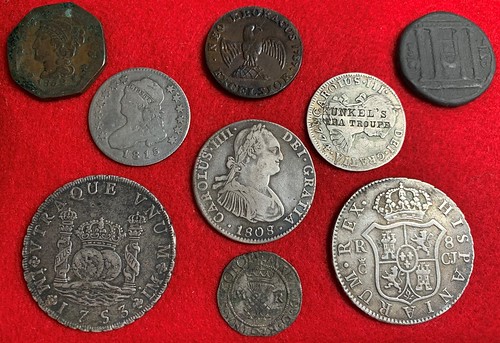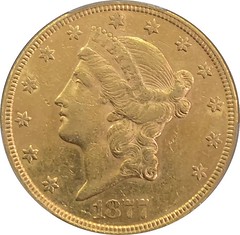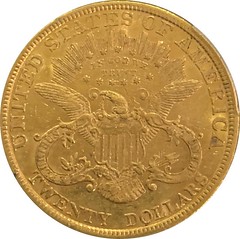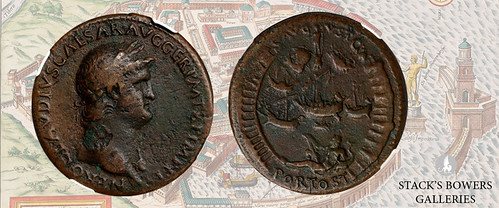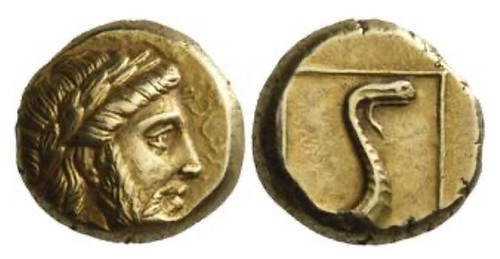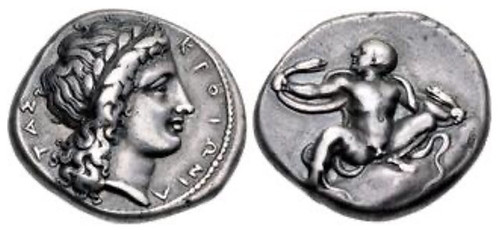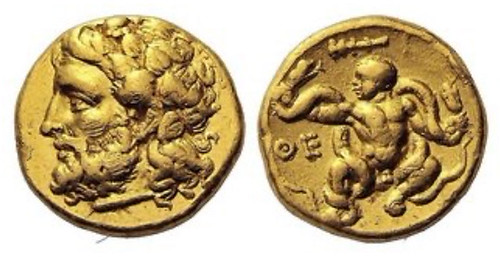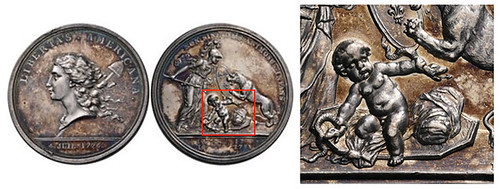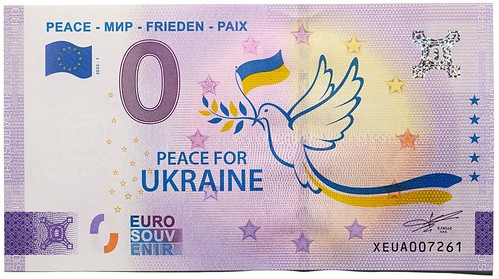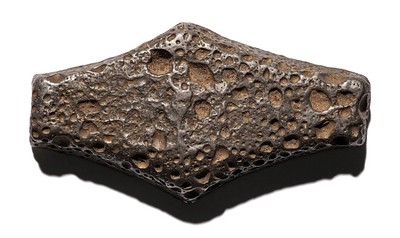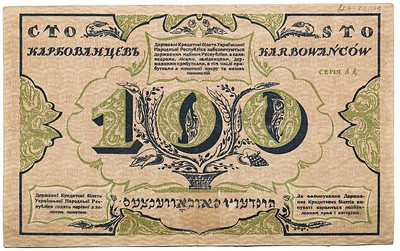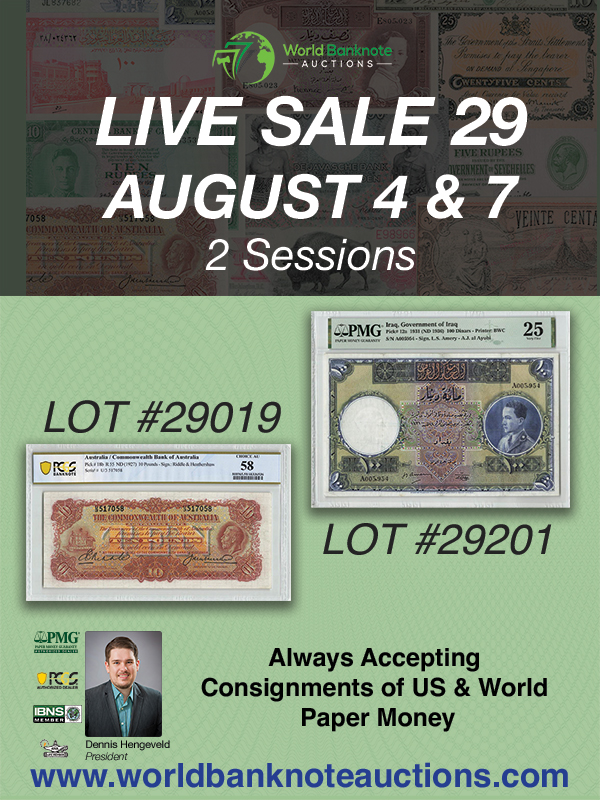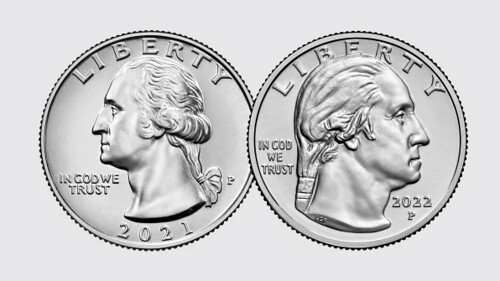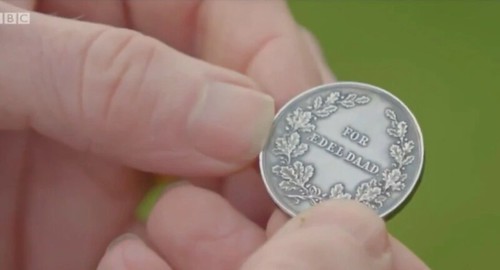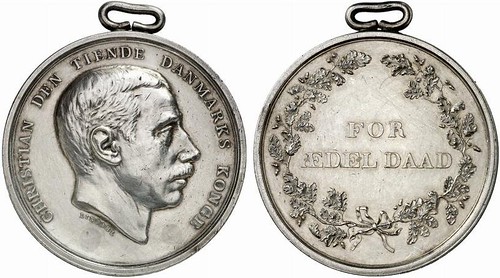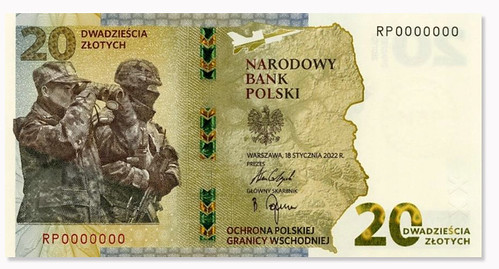
Visit our NBS Sponsors



About UsThe Numismatic Bibliomania Society is a non-profit association devoted to the study and enjoyment of numismatic literature. For more information please see our web site at coinbooks.org SubscriptionsThose wishing to become new E-Sylum subscribers (or wishing to Unsubscribe) can go to the following web page link MembershipThere is a membership application available on the web site Membership Application To join, print the application and return it with your check to the address printed on the application. Print/Digital membership is $40 to addresses in the U.S., and $60 elsewhere. A digital-only membership is available for $25. For those without web access, write to: Charles Heck, Treasurer AsylumFor Asylum mailing address changes and other membership questions, contact Chuck at this email address: treasurer@coinbooks.org SubmissionsTo submit items for publication in The E-Sylum, write to the Editor at this address: whomren@gmail.com BUY THE BOOK BEFORE THE COINSale Calendar |
- WAYNE'S WORDS: THE E-SYLUM JULY 24, 2022
- KOLBE & FANNING BUY OR BID SALE NUMBER 19
- NEW BOOK: TAKTIKON
- NEW BOOK: ONE LITTLE COIN
- NEW BOOK: A FACTOTUM IN THE BOOK TRADE
- GREYSHEET EXPANDS NUMISMATIC DATABASE
- NNP ADDS U.S. TREASURY PRESS RELEASES
- VIDEO: BENJAMIN FRANKLIN
- NOTES FROM E-SYLUM READERS: JULY 24, 2022
- THE UNDEAD CROOKED COIN DEALER
- VOCABULARY TERM: LACQUERED, LACQUERING
- JOSH TATUM REVISITED
- HARVEY STACK'S NUMISMATIC FAMILY, PART 126
- LOUIS VAN BELKUM
- FRED WEINBERG INTERVIEW, PART THREE
- NUMISMAGRAM MEDAL SELECTIONS: JULY 2022
- SOTHEBY'S OFFERS BUZZ ALDRIN MEDALS
- ARCHIVES INTERNATIONAL AUCTION 78
- STACK'S BOWERS TO OFFER VOLCKER COLLECTION
- NUMISMATIC NUGGETS: JULY 24, 2022
- WAYNE'S NUMISMATIC DIARY: JULY 24, 2022
- NERO'S PORT OF OSTIA SESTERTIUS
- SNAKES ON ANCIENT COINS
- THE HISTORY OF UKRAINE'S MONEY
- UKRAINE'S FIRST COMMEMORATIVES SINCE INVASION
- FRASER'S FLIP AND MODERN LOGO DESIGN
- FOR EDEL DAAD: THE NOVEL DEEDS MEDAL
- LOOSE CHANGE: JULY 24, 2022
Click here to read the thin version on the web
Click here to subscribe
Click here to access the complete archive
To comment or submit articles, reply to whomren@gmail.com
Content presented in The E-Sylum is not necessarily researched or independently fact-checked, and views expressed do not necessarily represent those of the Numismatic Bibliomania Society.
WAYNE'S WORDS: THE E-SYLUM JULY 24, 2022
Thank you for reading The E-Sylum. If you enjoy it, please send me the email addresses of friends you think may enjoy it as well and I'll send them a subscription. Contact me at whomren@gmail.com anytime regarding your subscription, or questions, comments or suggestions about our content.
This week we open with a numismatic literature sale, three new books, updates from the Greysheet and Newman Numismatic Portal, and more.
Other topics this week include U.S. Treasury press releases, lacquering, Josh Tatum and the Racketeer nickel, Louis Van Belkum, Buzz Aldrin, auction previews, snakes on ancient coins (with beards!), Ukraine's money, and the Novel Deeds medal.
To learn more about Bucknill's Coins of the Dutch East Indies, Otis Kaye's Heart of the Matter, the first clad coins, the Undead Crooked Coin Dealer, National Bank Notes, the Tsiolkovsky medal, the Benjamin F. Fairless medal, and the Victor Buono method of viewing coins, read on. Have a great week, everyone!
Wayne Homren
Editor, The E-Sylum
KOLBE & FANNING BUY OR BID SALE NUMBER 19
Numismatic Booksellers Kolbe & Fanning submitted this announcement of their nineteenth "Buy or Bid Sale" which closes on August 1, 2022. Good luck, everyone! -Editor
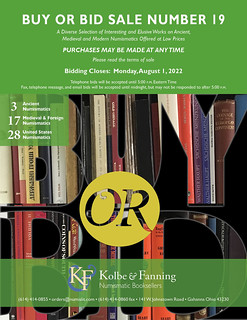 Kolbe & Fanning Numismatic Booksellers have announced our latest
Kolbe & Fanning Numismatic Booksellers have announced our latest Buy or Bid Sale,
which begins now and will close on Monday, August 1, 2022. With hundreds of new additions, the sale focuses on modestly priced books, giving collectors an opportunity to add to their libraries at minimal cost.
The sale includes over 1300 works on ancient, medieval and modern coins, as well as general works, periodicals and sale catalogues. Buy
prices have been kept low to promote sales. To further encourage participation, the firm is offering free domestic shipping to bidders spending at least $300; there is also no packing and processing fee for this sale. Again, please read the Terms of Sale before participating.
As the name of the sale suggests, customers may bid on items they wish to acquire or buy them outright at the published price. The Terms of Sale will give full instructions on how to participate: please read it carefully.
There is no printed catalogue. The PDF catalogue is available now for downloading from the Kolbe & Fanning website at numislit.com. Please send all bids to orders@numislit.com or use the bid sheet included at the end of the PDF catalogue.
To read the complete catalog, see:
https://www.numislit.com/images/upload/kolbefanningbob19.pdf
NEW BOOK: TAKTIKON
Bruce Perdue forwarded this announcement of a new book on Byzantine coinage. Thanks. -Editor
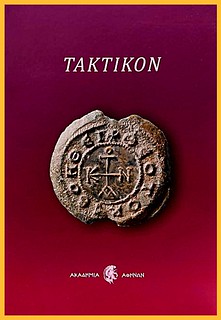 TAKTIKON- Studies on the Prosopography and Administration of the Byzantine Themata
TAKTIKON- Studies on the Prosopography and Administration of the Byzantine Themata
by Olga Karagiorgou, et al (eds.).
Academy of Athens, 2021.
Hard cover, 29 cm. 904 pp., ill.: 638 coloured photos, 241 B&W photos, 6 coloured maps.
Part I: aims and the methodological principles.
Part II: The thematic administration on the evidence of sigillographic and other sources: some case studies.
Part III: Unpublished molybdoboulla relevant to the administration of Byzantine Asia Minor; includes the papers by Nikolaj Alekseienko (Correspondents of Byzantine Cherson), Oleksandr Alf'orov (Seals of Eustratios Chrysoberges from the territory of the Rus'), Vera Bulgurlu (Seals from the Museum of Miletos), Jean-Claude Cheynet (A. Sceaux parisiens inédits, and B. Sceaux dans la collection Savvas Kofopoulos, Lesbos), Nilgün Elam (Seals from eleven museums in Turkey), Esra Güzel Erdogan and Vivien Prigent (Sceaux au musée d'Adana), and Elena Stepanova (Seals of the Kibyrraiotai from the Hermitage.
Part IV: Interpretations of the sigillographic material; includes the papers by Ivan Jordanov (Byzantine Eastern armies in the Balkans), Th. Kourempanas (Σφραγίδες με απεικονίσεις αετών), Valerij Stepanenko (The family of Artzruni) and Zhenya Zhekova (Thematic seals from Bulgaria).
The authors in Parts III and IV of the volume discuss more than 230 Byzantine lead seals (in their overwhelming majority previously unpublished), kept in private and state collections in Bulgaria, France, Greece, Russia, and the Ukraine, which are relevant to the administration and the prosopography of Byzantine Asia Minor.
For more information, or to order, contract Demetrius Siatras of Siatra Books:
dem.siatras@gmail.com
.
NEW BOOK: ONE LITTLE COIN
A Canadian Coin News article by Jesse Robitaille discusses a new children's book from the Royal Canadian Numismatic Association. We're republishing it here with permission. Thanks. -Editor
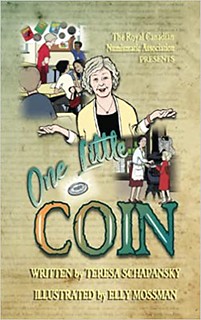 A new children's book published by the Royal Canadian Numismatic Association (RCNA) hit No. 1 on Amazon within a week of its release this June.
A new children's book published by the Royal Canadian Numismatic Association (RCNA) hit No. 1 on Amazon within a week of its release this June.
Written by best-selling author Teresa Schapansky and edited by RCNA national youth co-ordinator Cassidy Stroud, One Little Coin hit the digital shelves in both English and French on June 22. A few days later, Schapansky's 21st book reached the top spot on the Amazon Hot New Releases list for coins and medals. The book's in-person launch will take place at the RCNA Convention on July 22, the show's second of five days, when RCNA officials will offer copies autographed by Schapansky and illustrator Elly Mossman, both of Duncan, B.C.
It was a joy working with Teresa and Elly; they know what they're doing, and they're total professionals,
said Stroud, who's also the first vice-president and editorial director of the Ontario Numismatic Association.
She will be selling the book at the convention's Youth Booth,
where they'll be offered alongside free coins, banknotes and other numismatic material sourced from donations and given to children aged 17 and under. Each book sold at the convention will also include a numismatic gift that ties into the story,
according to Stroud.
The book is geared mainly to children, say under 12 or 13, but we're marketing it to the parents or family members of these young children to get them interested in coin collecting,
said Stroud, who added Schapansky's writing style is also great for children who might have reading struggles, so it could be appropriate for somebody a little bit older.
One Little Coin tells the story of a young girl who joins her school's coin club.
The book's blurb, found on the back cover, previews the story through one of the girl's journal entries: I signed up for the coin club, because to be honest, I really like money. Wasn't that what a coin club was about? Money? That, and how to get it, how much to keep and how much to spend?
I glanced around the room, and easily saw that the class was made up of quite an assortment of kids – polar opposites, in my opinion.
In the end, who could have guessed that seven totally different kinds of people would form such an unlikely bond in a coin club? Maybe one day, I'll find one little coin that will change my life, forever. Maybe I'll find it with Jacques's metal detector, or maybe it'll be stuck in some couch cushion.
To read the complete article, see:
RCNA children's book hits No. 1 on Amazon
(https://canadiancoinnews.com/rcna-childrens-book-hits-no-1-on-amazon/)
For more information, or to order, see:
One Little Coin Paperback – June 22, 2022
(https://www.amazon.com/One-Little-Coin-Teresa-Schapansky/dp/1778153208)
NEW BOOK: A FACTOTUM IN THE BOOK TRADE
For the bibliophiles among us, here's a new book about the book trade itself. -Editor
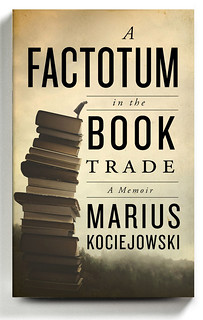 A FACTOTUM IN THE BOOK TRADE
A FACTOTUM IN THE BOOK TRADE
A Memoir
By Marius Kociejowski
349 pages. Biblioasis. $18.95.
I love the smell of old books. More than once, I've said those seven words aloud after entering a used and/or rare bookstore. It's a mistake I won't make again.
In his dyspeptic new memoir, A Factotum in the Book Trade,
Marius Kociejowski, who has worked in some of London's best antiquarian bookstores, turns me into a kebab when he writes:
There is a breed of Homo sapiens that will walk inside, take a deep breath, and say, Mmm, I just love the smell of old books.
They are to be got rid of as quickly as possible, with whatever violence it takes. I have heard the line a thousand times and never, never have I sold a book to any one of those people.
Many good memoirs have been written by antiquarian booksellers. The best of these, recently, is William S. Reese's Collectors, Booksellers, and Libraries: Essays on Americanists and the Rare Book Market
(2018), a restless book under a sleepy title.
A Factotum in the Book Trade
is memorable because a) it's well-written, and b) it's close in touch with the books. Kociejowski, now in his early 70s, never owned his own shop. He struggled financially while raising a family on an employee's earnings. He simply loved the work because, he writes, the book trade is a floating world for people of intelligence unsuited for anything else.
Used book dealers, in my experience, tend to be darkly witty. The Scotsman Shaun Bythell wrote, in his memoir The Diary of a Bookseller
(2018): I am putting a mental jigsaw together of what a hobbit looks like, based on a composite of every customer I have ever sold a copy to.
He's right about what a good bookstore should feel like. I want dirt; I want chaos; I want, above all, mystery,
he writes. I want to be able to step into a place and have the sense that there I'll find a book, as yet unknown to me, which to some degree will change my life.
I know that sort of store — it's the sort where you wish, browsing, you had a miner's lamp strapped to your forehead.
These kinds of bookstores are rapidly vanishing, Kociejowski laments, victims of the internet and now Covid. He loathes these new jumped-up bookshops that masquerade as art galleries with nice little walnut tables.
He talks a bit about famous customers he's served, including Patti Smith, who shares his fondness for Robert Louis Stevenson's essays. Philip Larkin would come in, looking for first editions of his own books. He sold a copy of Finnegans Wake
to Johnny Depp, who was trying incredibly hard not to be recognized and with predictably comic results.
He observes that librarians seem to hate books, eager as they are to perforate and stamp them. He is taught by a good bookseller how to polish books: Use your fingers, it is the softest leather you can ever find.
Truth be told, I hate the smell of old books. At least the musty smell of poorly stored books. But I enjoy the company of books, and of the fusty bibliophiles who buy, sell, collect and read them. -Editor
To read the complete article, see:
Love the Smell of Old Books? This Bookseller Would Like You to Leave.
(https://www.nytimes.com/2022/07/18/books/review-factotum-book-trade-memoir-marius-kociejowski.html)
GREYSHEET EXPANDS NUMISMATIC DATABASE
John Feigenbaum, the President, CEO and managing partner at CDN Publishing published an article this week on the expansion of the firm's numismatic database. -Editor
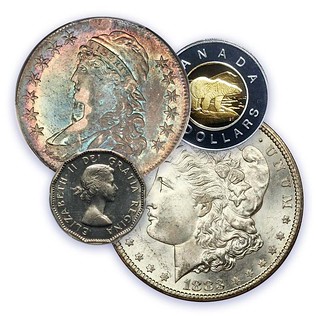 We have been extremely busy here lately working to expand the catalog of coins. Expanding the catalog is the first step to adding pricing, so it's a critical phase in the process. Over the past two months or so, we have added a number of exciting items, including some pricing. If you have an expertise and/or interest in helping build out the catalog, or supplying wholesale price information, please contact us at
editor@greysheet.com.
We have been extremely busy here lately working to expand the catalog of coins. Expanding the catalog is the first step to adding pricing, so it's a critical phase in the process. Over the past two months or so, we have added a number of exciting items, including some pricing. If you have an expertise and/or interest in helping build out the catalog, or supplying wholesale price information, please contact us at
editor@greysheet.com.
New Catalog Entries
1. Early Half Dollars (Overton): We've added 775 listings by Overton variety. With the help from our friends at the Bust Half Nut Club (link) we've also updated to the latest rarity-rating standards. Pricing has also been added for most items, especially those R1-R5.
2. Morgan Dollars (VAM): We now have 366 different Morgan dollars listed by VAM variety. While this is not the complete listing of VAMs, it does include the most popular ones, often designated as Top 100, Hot 50, and Hit List. We are slowly adding pricing for individual items as time and data permit.
3. World Coins: Canada: This one is a doozy. We get more requests from users for Canadian coinage listings than any other country. The good news is we are making great progress. Thanks to the help of a major wholesaler of Canadian coins we are also able to add reliable pricing in Silver dollars. Half dollars pricing coming soon.
Coming Soon:
1. Huge database of world coins: we are excited to make a major announcement in the next month regarding the addition of the majority of world decimal coinage. With this expansion, we will offer the largest catalog of numismatic material anywhere. Stay tuned!
To read the complete article, see:
Coin Catalog Update: VAMs, Overtons and Canadian
(https://www.greysheet.com/news/story/coin-catalog-update-vams-overtons-and-canadian)
To read an earlier E-Sylum article, see:
THE BANKNOTE BOOK ROADMAP
(https://www.coinbooks.org/v24/esylum_v24n26a06.html)
NNP ADDS U.S. TREASURY PRESS RELEASES
The latest addition to the Newman Numismatic Portal is a long run of U.S. Treasury press releases relating to numismatics. NNP Summer Intern Kellen Hoard provided the following report. -Editor
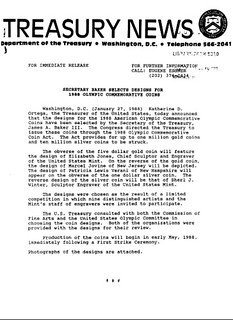 As my first year of college—and my first year of studying international relations—quickly
approaches, I have become acutely aware of how my work this summer with the Newman
Numismatic Portal intersects with my field of interest. Time and again, I find myself
encountering examples of international diplomacy in practice, directly and indirectly, through the
numismatic archival material I am encountering.
As my first year of college—and my first year of studying international relations—quickly
approaches, I have become acutely aware of how my work this summer with the Newman
Numismatic Portal intersects with my field of interest. Time and again, I find myself
encountering examples of international diplomacy in practice, directly and indirectly, through the
numismatic archival material I am encountering.
One project which yielded interesting international lessons involved newly discovered 1833 Mint letters from the National Archives, primarily to and from Mint Director Franklin Peale. Similarly, preparing dozens of Daniel Sedwick Treasure auction catalogs for publication on the NNP allowed mind-bending insights into historical international economic and political systems via the pieces listed within.
But one project, in particular, proved surprisingly relevant and instructional in my numismatic education on international relations: scouring and processing U.S. Treasury press releases from 1970-present. Earlier this summer, I began the process of tracking down every Treasury press release published in the last 52 years which related to numismatics. It was a task which required great patience—a trait my mother has repeatedly declined to ascribe to me—but which I found ultimately rewarding because of its lessons in my area of curiosity.
Treasury press releases are where that deeply influential government department shines a light for both the nation and, crucially, the world on the biggest economic priorities of the U.S. government. It became clear to me after searching through thousands of releases that, amid announcements of massive sanctions, inaugural addresses, and trillion-dollar bond sales, numismatic items remained an unshakeable presence in the Treasury's efforts to highlight American priorities. It was also intriguing to see that many of the releases uncovered which were clearly related to foreign affairs. A ban on Krugerrand imports. The release of Olympic coins. The marketing of those Olympic coins abroad. A ban on certain Mexican gold coins. Currency counterfeiting overseas, and how to stop it through redesigns of our paper money.
As numismatists, I think it is clear to many of us why numismatic-themed releases remained such a constant presence, even amid much larger announcements. We know that coins and paper money serve as perhaps the most clear—or, at least, the most tangible—expressions of national values and priorities. Money is how governments communicate most effectively. By highlighting, constantly across decades, the ban on, sale of, or redesign of such items—especially the numismatic items which most directly related to the United States' foreign relations—the Treasury was effectively reaffirming those values and priorities to the world. Whether this was intentional on their part is a subject for further debate. But the effect, I feel, was the same. By elevating such announcements to the highest official channel, the world became more cognizant of what we stood for. That can only be a good thing.
It's worth checking out some of these releases. You can do so here:
https://nnp.wustl.edu/library/publisherdetail/543206?Year=1978&displayAmt=50
Wow - this is an amazing resource for collectors and researchers, now brought up to the present and going all the way back to Secretary McAdoo's 1917 statement encouraging the use of gold certificates instead of gold coins and 1918 Federal Reserve statements discouraging the use of gold coins as Christmas presents "for we are not yet through with war financing and the problems which grow out of the war and reconstruction..." Thanks, Kellen! -Editor
VIDEO: BENJAMIN FRANKLIN
These are selections from the David Lisot Video Library that feature news and personalities from the world of coin collecting. David has been attending coin conventions since 1972 and began videotaping in 1985. The Newman Numismatic Portal now lists all David's videos on their website at:
https://nnp.wustl.edu/library/multimediadetail/522852
Here's one on Ben Franklin, as portrayed by Pat McBride. -Editor
Ben Franklin, Numismatist.
VIDEO: 37:19.
Patrick McBride, Actor,
franklinalive.com,
David Lisot, Video Producer, CoinTelevision.com,
May 20, 2022.
Most people familiar with history think of Benjamin Franklin as a printer in his early life. He became an international statesman and diplomat later and played a crucial role in American independence. Patrick McBride plays the role of Franklin at the Pennsylvania Association of Numismatists Convention and tells the fantastic story of his life with emphasis on his role in numismatics.
David adds:
"Patrick McBride has become an icon of numismatic spirit for his decisive and startling rendering of Benjamin Franklin. His character brings a sincerity to the role reminiscent of Dennis Boggs' portrayal of Abraham Lincoln. If you want to learn the story of Ben and feel like you are actually in his presence you will enjoy this video."
An excerpt of the video is available for viewing on the Coin Television YouTube Channel at:
https://youtu.be/lR7zpfbKrTk
NOTES FROM E-SYLUM READERS: JULY 24, 2022
On Bucknill's Coins of the Dutch East Indies
Bob Van Arsdell writes:
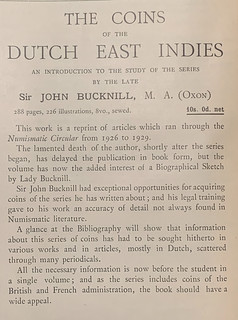 "I saw John Madlon's article about Bucknill's Coins of the Dutch East Indies and thought it looked like an offprint. The book turns out to be a compilation of articles that ran in the Numismatic Circular in the late twenties. I've attached a photo of the announcement for the offprint in the Aug/Sep 1931 Circular.
"I saw John Madlon's article about Bucknill's Coins of the Dutch East Indies and thought it looked like an offprint. The book turns out to be a compilation of articles that ran in the Numismatic Circular in the late twenties. I've attached a photo of the announcement for the offprint in the Aug/Sep 1931 Circular.
"People who need a copy of the book have another source for the content."
Thanks. -Editor
To read the earlier E-Sylum article, see:
NOTES FROM E-SYLUM READERS: JULY 17, 2022 : More on M. H. Rubenstein
(https://www.coinbooks.org/v25/esylum_v25n29a09.html)
MARGOOD Coin Boards
Dave Lange writes:
"I enjoyed reading the interview with Fred Weinberg, who is one of the great guys in the coin business. Several times he mentioned Arnold Margolis and Mort Goodman. I knew the former but never met Goodman.
"I do, however, have something they produced back in 1965 which fits right in with Fred's recounting of their efforts to promote error coin collecting. It shows an educational coin board for error cents that was published by MARGOOD and offered for several years. Also attached is an ad for this item from the September 1967 issue of COINage. I love the old magazines from the 1960s-70s, because they're often the only source of such information. As yet they're not available at the NNP, so I have about a dozen linear feet of shelf space tied up with scarce hard copies. I know I'll never recover what it cost to obtain these, but they're priceless to me.
"The MARGOOD board is quite rare, and I've seen only three examples over the years."
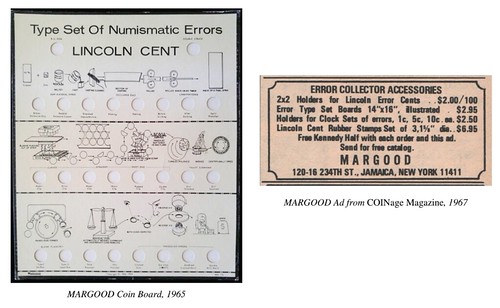
Indeed - I've never seen one of these. Great hobby history. Thanks! I knew Arnie Margolis, but never met him in person. I built a website for him and helped maintain it for a number of years. -Editor
To read the earlier E-Sylum articles, see:
COIN BOARDS AND RELATED EPHEMERA
(https://www.coinbooks.org/v20/esylum_v20n49a15.html)
FRED WEINBERG INTERVIEW, PART TWO
(https://www.coinbooks.org/v25/esylum_v25n29a17.html)
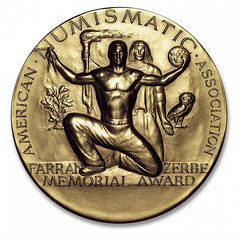 More on Justice for Zerbe
More on Justice for Zerbe
Greg Burns writes:
"I agree that the Zerbe issue seems to be an example of what my generation called "railroading", and in this case, with someone not current to defend their name."
To read the earlier E-Sylum article, see:
NOTES FROM E-SYLUM READERS: JULY 17, 2022 :
Justice for Zerbe?
(https://www.coinbooks.org/v25/esylum_v25n29a09.html)
Cover Image: Heart of the Matter
Regarding the image used on the cover of the Currency of Politics book discussed last week,
Pete Smith writes:
"The attached painting image is Heart of the Matter painted by Otis Kaye in 1963."
Thanks. I figured it was from the American school of trompe l'oeil "fool the eye" artists such as William Harnett and Otis Kaye. What I hadn't figured on was that I'd actually seen the painting itself and should have known the answer! -Editor
Pete adds:
"You should remember, you saw the painting at the Art Institute of Chicago in April 2018.
"Many years ago I walked through the Art Institute of Chicago and ended at the gift shop. I saw a post card for American Gothic. I asked for directions and dashed back into the museum to see it."
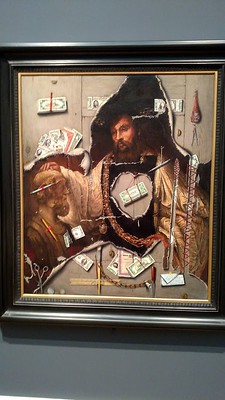 Well yeah, I didn't remember. I published a photo I'd taken of the painting in my Numismatic Diary for that week (linked below). In my defense I could say I was snow-blind from the relentless parade of world-class masterworks I'd seen on that museum visit.
Well yeah, I didn't remember. I published a photo I'd taken of the painting in my Numismatic Diary for that week (linked below). In my defense I could say I was snow-blind from the relentless parade of world-class masterworks I'd seen on that museum visit.
There were no guesses from other readers, so Pete has won a Smarty-Pants award of his own. Great work! -Editor
To read the earlier E-Sylum articles, see:
WAYNE'S NUMISMATIC DIARY: APRIL 29, 2018 : The Art Institute of Chicago
(https://www.coinbooks.org/v21/esylum_v21n17a31.html)
NEW BOOK: THE CURRENCY OF POLITICS
(https://www.coinbooks.org/v25/esylum_v25n29a04.html)
More on the ANS Donald Partrick Building Medal
Scott Miller writes:
"I was pleased to see the article on Donald Partrick in the most recent E-Sylum. I would like to add one minor correction. The statement that Partrick is not named on the ANS medal is only partly true. While his full name was not listed, his initials DPG can be seen to the left of the truncation of his bust."
For more information on the medal, see:
Bronze Medal of American Numismatic Society, United States, 2004. 2009.16.1
(http://numismatics.org/collection/2009.16.1)
To read the earlier E-Sylum article, see:
DONALD G. PARTRICK (1926-2020)
(https://www.coinbooks.org/v25/esylum_v25n29a14.html)
More Numismatic Photos
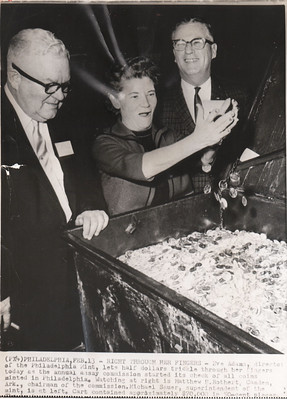 Dave Lange writes:
Dave Lange writes:
"I acquired another numismatic photo that depicts Mint Director Eva Adams raining down newly minted half dollars. The only date given is February 13, but the action takes place during the annual gathering of the assay commission. Adams was director 1961-69, and the only year during that period when the commission met on the 13th was 1963, so the coins bore that date.
"She's accompanied by Philadelphia Mint Superintendent Michael Sauer (left) and Matt Rothert (right), ANA First Vice-President 1963-64 and President 1965-66. Rothert is identified in the photo as Commission Chairman, but the book by Francis Pessolana-Filos assigns that role to J. Madison Hunnicutt, Jr.
"The bright streaks emanating from Adams' hair are wrinkles in the print, and she did not have a Bride of Frankenstein hairstyle."
Dave adds:
"Another new arrival shows President Lyndon Johnson receiving an acrylic block holding obverse and reverse examples of the new 1965-dated coins. It was taken as he signed the Coinage Act of July 23, 1965. Of course, this legislation gave us our current copper-nickel-clad dimes and quarters, as well as the silver-clad halves issued until 1971. Handing him the block is Senator John Sparkman (D-AL, left) and Representative Wright Patman (D-TX, right).
"The print was made from an Associated Press wire photo, which means that it was printed out from an electronic transmission. The quality of such prints is not great, as I learned four years ago when I was one of several NGC people drafted to catalog material from the Armstrong Family Collection certified by NGC's companion company, CAG. I wrote descriptions for hundreds of such photos that had been sent to Neil Armstrong during his time as an astronaut, and all were just a bit indistinct."
Thanks for collecting and sharing these. Very cool! -Editor
To read the earlier E-Sylum article, see:
NOTES FROM E-SYLUM READERS: JULY 17, 2022 : Bicentennial Coin Design Finalists Photo
(https://www.coinbooks.org/v25/esylum_v25n29a09.html)
John A. Pople Nobel Prize Medal
Pat McBride writes:
"There is a Nobel Prize medal displayed in the Hunt Library on the CMU campus."
Thanks for the photos! I've been to the Carnegie Mellon University campus many times, but I should be ashamed to say I never darkened the door of the Hunt Library. From another photo of the exhibit, "Dr. Pople won the Nobel Prize for developing first principles computational techniques to understand and predict the chemical structure and details of matter, simplifying the mathematical description of the bonding between atoms that make up molecules." -Editor
The Victor Buono Method
Pete Smith writes:
"I came across an amusing article published in The Hanford Sentinel for April 1, 1971. I don't have the patience to hold this for the next April 1 issue of The E-Sylum. This illustrated the Victor Buono method of examining a coin.
"Smarty-Pants question of the week. Who can explain the Victor Buono method?"
What say you, readers? -Editor
THE UNDEAD CROOKED COIN DEALER
An E-Sylum reader shared this cautionary tale noting, "Thank you for your piece this week entitled, The Undead Numismatist.
My letter can be entitled, The Undead Crooked Coin Dealer,
and should be read by every collector."
-Editor
 The American Numismatic Association (ANA) knows my story from 2014, when I asked it to
intercede with the dealer on my behalf, after he sold me two raw coins which he claimed were genuine:
a very nice 1937-D Three-Legged Buffalo Nickel, in AU-55 condition; and a 1916-D Mercury Dime in AU-50 condition. The two coins lay alone under glass under his front counter, and I later realized that the
nickel, which was later graded by Professional Coin Grading Service as AU-55, was used as bait for the
dime, which a major dealer in New York City days later told me looked counterfeit upon close
examination. I remain docked for a sum in the mid-to-high four figures, six years after getting an
uncontested award from my area's Small Claims Court in Westchester County, New York, just north of
New York City. (A local lawyer had advised me to go myself to that court, not to pay expensively for
legal advice at this level of loss.)
The American Numismatic Association (ANA) knows my story from 2014, when I asked it to
intercede with the dealer on my behalf, after he sold me two raw coins which he claimed were genuine:
a very nice 1937-D Three-Legged Buffalo Nickel, in AU-55 condition; and a 1916-D Mercury Dime in AU-50 condition. The two coins lay alone under glass under his front counter, and I later realized that the
nickel, which was later graded by Professional Coin Grading Service as AU-55, was used as bait for the
dime, which a major dealer in New York City days later told me looked counterfeit upon close
examination. I remain docked for a sum in the mid-to-high four figures, six years after getting an
uncontested award from my area's Small Claims Court in Westchester County, New York, just north of
New York City. (A local lawyer had advised me to go myself to that court, not to pay expensively for
legal advice at this level of loss.)
When in 2014 I told the ANA about my case, its relevant official(s) told me they couldn't help me because the dealer, several years earlier, had stopped paying the annual dues for his own ANA dealer's membership. I said that was a real disappointment, since he still had the certificates of membership-in-good-standing of all the leading professional numismatic organizations festooned around his walls. After I told that to the ANA, I noticed soon afterwards that those certificates had all been removed.
I knew the dangers of counterfeiting, especially of 1916-D dimes. But I had been a customer of this dealer for a dozen years, almost entirely in buying and selling precious metals, not collector coins. And we had always had a good relationship. I had trusted him implicitly and just assumed that both coins would be problem-free. My fault. That's what was surprising and disappointing. Since then, I have always said that if that guy needed the money so badly, it's better he cheated me rather than the other way around. I can still look at myself in the mirror in the morning.
Later that year of 2014, the dealer went into an area hospital claiming to customers that he had
a life-threatening illness. Later, when I spoke to his daughter, who often was in the shop (because she
drove him; he had lost his license in 2011 for failing to answer a court summons), she claimed on the
phone: He died.
But some years later, another coin dealer in this area who knows him well told me:
He's not dead. He's just a crook. But he's a drug addict.
A year or so before my loss, the dealer's shop had been robbed one morning at gunpoint, and he lost $10,000 in cash – perhaps to a disgruntled customer – even though he was, of course, always armed himself. (The dealer was also a military veteran.) On another occasion, I learned from nearby shopkeepers in the same mall that his home had recently been burgled and the family had lost a lot of jewelry, precious metals, cash and other valuables. The incidents were said to have been reported in the newspapers.
Because of the robbery of his shop, the dealer tried to sue the mall owner for not maintaining a safe environment. The dealer lost that case, and soon the mall owner moved to evict him for his non- payment of rent.
On top of all that, the family were suing the school district where the dealer's grandson
attended high school, claiming negligence of the school district because the boy had reportedly hurt
himself one day during physical education class. The dealer and his daughter for months claimed they
would repay me, with interest,
after they won that case. But after three years, they lost that case,
both at trial and on appeal.
About 1 1/2 years ago, a law firm in New York City wrote to me out of the blue, to say it would take on this case for me on a contingency basis, to search for assets of the dealer, if I agreed, and I did so. I told them how the dealer probably still goes to estate sales and presumably still deals in bullion out of his home, probably using his grandson's surname, which is very different from his own name.
This dealer no doubt pulled similar stunts on other trusting customers as the burden of his finances grew desperate, given his medical problems, pending divorce and legal costs. He must have been sued by many others but could declare bankruptcy, sheltering his home under his daughter's name, while surreptitiously hiding his wealth in many ways. It's easy to squirrel away assets that are small in size but significant in value.
It's comforting to know that legal eager beavers are out there scouring the landscape for all the
ways your article suggests that the NYC area investigators, Ahearn and Rambam, obsessively
try to
trace a debtor's movements, finances, relationships, and anything else that might lead them to their
quarry. Who knows? The two outfits might be hunting the same suspect and could be collaborating. Or
they might well be different suspects.
Finally, every collector should follow the advice of lawyer Armen Vartian, the long-time legal columnist for Coin World, to whom I wrote in this matter. Mr. Vartian's last CW column appeared in the 15 December 2014 edition, after 18 years of giving advice to CW readers, and summarized his five main rules for coin collectors as follows:
(1) Get it in writing
(which was also the title of his last CW column).
(2) Do your research first,
specifically on the market value of coins and the reputation of dealers.
(3)
Settle disputes,
if possible, because compromise is usually wiser, cheaper and faster than litigation.
(4) Use lawyers,
because even though they can be expensive, lawyers are worth the money.
And (5)
Use your common sense
whenever doing business and contemplating the ethical dimensions of a proposed deal. (Mr. Vartian is the author of A Legal Guide to Buying and Selling Art and Collectibles.)
To read the complete article, see:
LOOSE CHANGE: JULY 17, 2022 : The Undead Numismatist
(https://www.coinbooks.org/v25/esylum_v25n29a28.html)
VOCABULARY TERM: LACQUERED, LACQUERING
Here's another entry from Dick Johnson's Encyclopedia of Coin and Medal Terminology. -Editor
Lacquered, Lacquering. Lacquered, Lacquering. The applying – by spraying, dipping or brushing – of a fine coat of lacquer to metallic surfaces. Spraying is the best method for uniform thickness; dipping results in a thicker coat, the excess must be drained; brushing is sometimes difficult to eliminate brush strokes. See lacquer.
Lacquer Stick. A form of solid lacquer which when rubbed over a heated metal object with incuse areas will melt the lacquer, it flows into the incuse areas to give them color. As the metal cools the colored lacquer hardens and is retained in the crevices. Lacquer sticks are available commercially in black, white, red, orange, blue, green, yellow, silver and gold colors. This is one form of fill-in (others are monogram filler, champlevé and enamel paint). See fill-in.
To read the complete entry on the Newman Numismatic Portal, see:
Lacquered, Lacquering
(https://nnp.wustl.edu/library/dictionarydetail/516203)
JOSH TATUM REVISITED
American Numismatic Biographies author Pete Smith submitted this article on Josh Tatum and the Racketeer Nickel. Thanks! -Editor
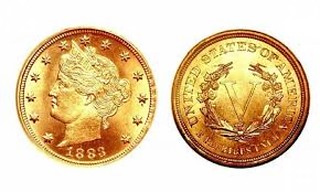 In the May 7, 2000, issue of The E-Sylum, I wrote,
In the May 7, 2000, issue of The E-Sylum, I wrote, I think it would be an interesting exercise for E-Sylum readers to try to come up with the first published reference to Tatum.
I am still looking for that first reference.
When a new United States nickel coin was issued in 1883, there was no shortage of reporting in the papers. I have selected a few stories out of hundreds that were printed in 1883.
The Evening News (Emporia, KS) reported on February 14, 1883:
The banks here have received their first installment of the new nickel coin.
The Burlington (VT) Free Press carried an item on February 16, 1883:
Keep shy of half-eagles. You may get a gold-plated nickel.
The Weekly Public Ledger (Memphis, TN) printed on February 20, 1883:
Washington, February 11.-The objection of secret service men to the new five cent coin, which they claimed could be made to resemble a $5 gold piece by gilding has, it is reported, caused the Treasury Department to order an immediate suspension of further coinage by Mr. Snowden, Director of the Mint at Philadelphia.
The Semi-Weekly New Era of Lancaster, Pennsylvania, carried his item on February 24, 1883:
Col. Snowden, the Superintendent of the Mint, is credited on Wednesday of this sentiment regarding the new nickel coin:
They are good enough. What's the matter with them? The omission of the word ‘cents' does no harm. If any one is fool enough to take a gilded one for $5, let him suffer for his dumbness.
The Chicago Tribune reported on March 15, 1883:
This morning the police in Morgan City arrested a man named G. F. McCord, alias Mack, charged with having passed as $5 gold pieces a number of gilded new nickels.
Arkansas City (KS) Weekly Traveler of April 25, 1883 reported:
F. G. Mack, who at Morgan City, Mis., attempted to pass a new nickel as $5, was sentenced to five years at hard labor and to pay $1.000 fine.
The Burlington (VT) Free Press reported on March 28, 1883:
W. C. Woodward was arrested today on charge of passing gilded nickels for $5 gold pieces at St. Louis. Woodward knocked down two policemen and ran. He was fired at and finally caught. Woodward is a newspaper reporter.
The Cincinnati (OH) Enquirer reported for March 30, 1883:
As the Louisville and Nashville train was entering St. Louis, Woodward suddenly jumped past his custodian, dashed back through two passenger cars and jumped off the rear end of the train down an embankment. It was dark and Yost lost him among the freight cars which do there
abound.
The Daily American (Nashville, TN) of January 8, 1884, finished the story:
W. C. Woodward, the ex-Nashville journalist, gave himself up to the United States authorities here today… He was detained until information was received by telegraph to the effect that Woodward was no longer wanted in St, Louis, as the indictment against him had been found under a misapprehension of the facts.
In 1883 there were many reports about gold-plated nickels, some arrests, some convictions and some acquittals. The 1883 nickels without CENTS were hoarded in large numbers.
Three people in the United States named Joshua Tatum were born before 1871.
Joshua Tatum (3/30/1800-12/6/1883) was a farmer living in Mississippi and fought for the Confederacy.
Joshua Tatum (1808- ) was a farmer in Cyprus Creek Township, North Carolina.
Joshua Young Tatum (1848-3/9/1898) was a farmer in Perry County, Tennessee.
There was no Josh Tatum in Boston in 1883. The story has been false since its first telling, whenever that was.
Some sources credit Maurice M. Gould with first telling the story in his syndicated column Coin Roundup
appearing in, among others, The Sioux City (IA) Journal of August 8, 1965. As with most articles written about Tatum, this is not correct.
An article by Eber Higgins in Garfield County News (Enid, OK) for June 22, 1962, tells a version of the Tatum story.
An article by Don Millsap in Grand Prairie (TX) Daily News of June 29, 1959, tells the Tatum story.
An article by Liana Spurrier in Coin Week of January 16, 2019, places the first reference to The Southwest Times (Pulaski, VA) of December 14, 1958, and a presentation by Miss Willie Long before the Southwest Numismatic Society.
Julia Casey found a May 22, 1955, article in the Dayton (OH) Daily News. There was an earlier article on May 1, 1955, in The Wichita (KS) Eagle, by Michael MacDougall. Interesting that he referred to the culprit as Joshua Tatum.
MacDougall's report was on an item found in a collection. It appears that he was repeating a story and not making one up. The original Josh Tatum source has still not been found.
If the Josh Tatum story did not appear in a newspaper, and does not show up in all the documents on the Newman Numismatic Portal, then where does it come from? I suspect it may have appeared in a popular non-numismatic magazine. I searched magazine databases through my local library but had no success. The truth is out there. Who will find it?
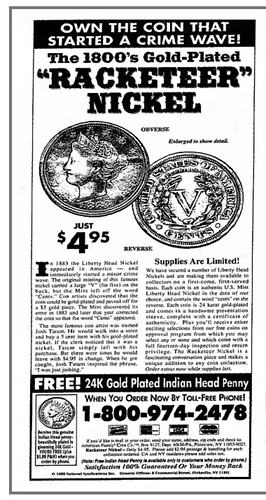 I was amused to see an ad for
I was amused to see an ad for Racketeer Nickels
in The Daily Oklahoman for February 21, 1999. The coin illustrated is the 1883 with CENTS reverse. The ad notes that they will provide dates of their choice.
When I worked for a coin dealer we had a small bag of gold-washed Liberty Nickels in dates other than 1883. We considered them worthless.
Thanks, Pete! Keep searching, folks! Who will be the first to locate the missing source? -Editor
Coin image from:
Well worn Copper's Blog
(https://www.money.org/collector/user_7715/blog/
1883-racketter-nickels-an-assortment-of-fakes)
To read the earlier E-Sylum articles, see:
DON'T JOSH ME
(https://www.coinbooks.org/
esylum_v03n18a08.html)
WHO'S JOSHING WHO?
(https://www.coinbooks.org/
esylum_v03n19a10.html)
JOSH TATUM RACKETEER NICKEL REFERENCES PRIOR TO 1968
(https://www.coinbooks.org/esylum_v10n08a15.html)
SEEKING (BUT NOT FINDING) JOSH TATUM
(https://www.coinbooks.org/v22/esylum_v22n07a07.html)
MORE ON JOSH TATUM AND THE NICKEL GYP GAME
(https://www.coinbooks.org/v22/esylum_v22n08a21.html)
HARVEY STACK'S NUMISMATIC FAMILY, PART 126
Stack's Bowers has a backlog of the late Harvey Stack's numismatic memoir articles and will continue publishing them. In this one Harvey moves to the year 1999. -Editor
As we entered the last year of the nineteen hundreds, Stack's was still thriving at its landmark address on West 57th Street near Fifth Avenue and Central Park. Our retail shop, with sit down counters and wonderful displays still had its club house
atmosphere that attracted both the public and seasoned collectors to visit, buy coins, and gather information. It didn't seem to matter what the address was, Stack's Rare Coins managed to keep its welcoming environment, even as the business expanded both as a retail presence and on the auction scene.
During the decades we served the hobby and its collectors we were fortunate to build many of the most important and outstanding collections formed in numismatics, and we were privileged in offering many at public auction or private sale. We were thrilled over the years to have worked with some of the most important collectors in the country, including Louis E. Eliasberg and Josiah K. Lilly, but we were also proud of the service that we provided to collectors at every level and no matter what their budget.
Members of the firm were active in national numismatic affairs and always strove to improve and assist the hobby to grow. As I noted earlier, I was proud to have played a role as an advocate for numismatics in dealings with the government, both in resisting the unfair gold import restrictions and in working toward the enactment of the Hobby Protection Act. I worked with others in conjunction with the American Numismatic Association to introduce grading standards and served on the board and as president of the Professional Numismatists Guild.
Over more than 65 years, the Stack family had been dedicated to the firm, from my father, Morton and his brother Joseph (the founders of Stack's Rare Coins), to the next generation of my cousins Ben and Norman and myself. As 1999 began, the family legacy had been passed to me and my son, Larry, and we worked hard to be sure it continued into the next century.
1999 would mark the first year of the State Commemorative Quarter program with five new quarter designs being issued at face value. These featured the states of Delaware, Pennsylvania, New Jersey, Georgia and Connecticut, the first five states to join the United States. I was very proud of my role in these new issues, and having been instrumental in creating a collectible that everyone could find in their daily change.
All of us at Stack's over the years were honored that as professional numismatists we could contribute to the future growth of the hobby that our family had been so personally involved with for so many years.
To read the complete article, see:
GROWING UP IN A NUMISMATIC FAMILY
(https://stacksbowers.com/growing-up-in-a-numismatic-family/)
To read the earlier E-Sylum article, see:
HARVEY STACK'S NUMISMATIC FAMILY, PART 125
(https://www.coinbooks.org/v25/esylum_v25n28a14.html)
LOUIS VAN BELKUM
While researching a book recently, I reached out to Peter Huntoon, who pointed me to a chapter he wrote about pioneer National Bank Note researcher Louis Van Belkum in the new Encyclopedia of U. S. National Bank Notes published jointly by the National Currency Foundation and Society of Paper Money Collectors. With permission, we're republishing it here. Thanks! -Editor
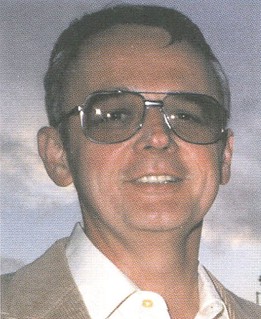 The birth of the modern era of national bank note
collecting can be definitively fixed at 1968 when Louis
Van Belkum's landmark
The birth of the modern era of national bank note
collecting can be definitively fixed at 1968 when Louis
Van Belkum's landmark National Banks of the Note
Issuing Period, 1863-1935
was published.
This book, which summarized a thumbnail history of every note-issuing national bank, also listed the final circulations for the banks. Lou abstracted the information from endless tables found in the 68 annual reports of the Comptroller of the Currency spanning 1863 through 1935.
It became an instant buyer's guide for those of us chasing nationals, and was so successful it was reprinted in 1973. For the first time, we had some idea of what was out there and how much it totaled.
But that was only the beginning of this man's monumental contribution to national bank note research. Over the next 11 years, from 1968 to 1979, he and his wife Barbara compiled the bank-by-bank issuance data for every note-issuing bank in the country.
This Herculean task at last count involved tracking 12,631 different banks that issued 81,259 different sheet combinations over a period of 67 years. To compile this enormous trove of data, they had to sift through 410 huge ledgers housed at the National Archives, which were then located in Washington, DC, but now in College Park, Maryland.
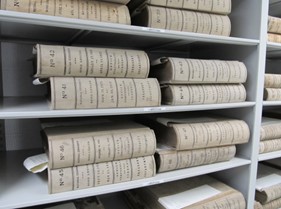 This benchmark achievement
quantified national bank notes. We
now had at our fingertips exactly what
was issued and how many by every
bank in the country. The modern era
of national bank note collecting rested
on a bedrock solid foundation. All else
that has followed is window dressing.
This benchmark achievement
quantified national bank notes. We
now had at our fingertips exactly what
was issued and how many by every
bank in the country. The modern era
of national bank note collecting rested
on a bedrock solid foundation. All else
that has followed is window dressing.
At the time, Louis was a high school math teacher in Grand Rapids, Michigan. He and Barbara embarked on marathon driving trips to DC that typically lasted 3 or 4 days. Their typical pattern was to leave on a Friday and drive straight through for 11 hours with the two of them switching off on the driving.
Once there, they hit the ground running at the National Archives, which involved frantically and doggedly writing by hand the information they gleaned from the ledgers.
Upon returning home—another straight 11-hour drive—they then typed the information on 5 by 7-inch cards. This was no small task, especially for Lou because he was a two-finger typist. Ultimately, they assembled cards for all 12,631 issuing banks, many of which ran on for more than one card.
They found it expedient to have microfilm made of certain crucial ledgers, which allowed Lou to pour over critical pages at home. He did not have to examine every ledger page for every bank. Rather he focused on the pages that captured series totals and the pages that spanned the Series of 1882 and 1902 date-back to post-date back changeovers. Most of this work was done in the National Archives reading room where they could work on ledgers that they checked out. The National Currency and Bond Ledgers still yield Lou's pull slips.
A July 25, 1974 Louis Van Belkum National Archives pull slip for some National Currency and Bond Ledgers complete with his signature.
This work was carried out for individual state collectors who would contract with him to compile information on a state or county basis at a fixed charge per bank. As the program gained momentum, the data was traded around and accumulated by both John Hickman and Lyn Knight.
In time, Hickman convinced William Higgins of the Higgins National Bank Note Museum in Okoboji, Iowa, of the merits of these data, so after all other avenues were tapped out, Higgins sprang for the orphan states so Louis could complete the job.
The data became widely available in 1981 with publication of Don Kelly's National Bank Notes,
a guide with prices
followed by the Hickman-Oakes Standard Catalog of National Bank Notes
in
1982.
Along the way, in 1970, Louis collaborated with M. Owen Warns and Peter Huntoon to produce
the blue book of 1929 nationals, The National Bank Notes Issues of 1929-1935.
Van Belkum is known by us as Louis or Lou; however, within his family he went by Bill. He was born October 8, 1942 in Grand Rapids, Michigan, and named Louis William Van Belkum III.
His odyssey into national bank notes started when he began collecting Michigan nationals in 1964. He sold most of his collection in 1976 through a Donlon auction but the last of his Michigan holdings came out in a June 3-5, 2009 Lyn Knight sale.
Van Belkum assembled a state collection of $5 1929 nationals that was complete or virtually complete. This was his Arizona note
He and Barbara moved to Las Vegas, Nevada, in February 1989 when he took a position with Clark County, where he served as a software programmer for their large IBM system. He retired in 2003.
He became heavily involved in collecting casino chips while in Las Vegas.
Lou succumbed July 31, 2013, to Alzheimer's disease at age 70, in Grand Rapids, to which he and Barbara returned in February 2010. He was survived by Barbara, his wife of 50 years, and his children Sandra, Paula and Louis William IV.
Van Belkum's compilation of national bank note issuance data probably ranks as the largest single block of numismatic research ever undertaken by an individual and will forever loft him to the highest ranks of numismatic researchers. Every national bank note collector is in his debt.
For more information on the two organizations, see:
http://www.nationalcurrencyfoundation.com/
https://www.spmc.org/
FRED WEINBERG INTERVIEW, PART THREE
Published in Errorscope earlier this year, Greg Bennick's interview with dealer and longtime E-Sylum supporter Fred Weinberg is a wonderful look at the hobby and business of error coin collecting over the last half century. With permission from the Combined Organization of Numismatic Error Collectors of America (CONECA), we're republishing it here. Here's part three of four, where Fred discusses some of his favorite major error coins. -Editor
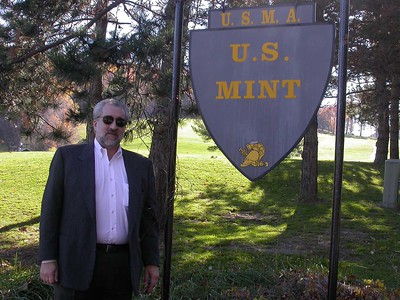 Greg Bennick: Along those lines, what are some specific major errors that you know of that are out there but
haven't seen the light of day in decades? As you said there weren't a lot of error collectors in the 1930's and 1940s so I wonder about years gone by. My dad even once told me that he thought errors were illegal to
collect early on.
Greg Bennick: Along those lines, what are some specific major errors that you know of that are out there but
haven't seen the light of day in decades? As you said there weren't a lot of error collectors in the 1930's and 1940s so I wonder about years gone by. My dad even once told me that he thought errors were illegal to
collect early on.
Fred Weinberg: There were articles that said the Secret Service would confiscate them, and once or twice the Secret Service did, but it turned out that it was mostly false alarms. The Secret Service rarely did that. So I never worried about it.
As far as specific coins, I mean I can think of two that pop off the top my head. One which has to do with the Bolt Collection, and then another one which is another fascinating coin. Let me tell you about the first one.
So in this Bolt Collection there was there was a Gem 1919 Standing Liberty Quarter broad struck on a type one blank that was the size of almost a half dollar. It was spectacular. There was also a 1895 $5 gold piece, 30% off center at 12 o'clock. Gem BU, semi proof like surfaces. I mean there were half cent, large cent errors, off metal type coins. Just incredible material.
One of my favorite coins was an 1888 Liberty nickel with a brass coil struck into the reverse of the coin. And the coil looked like a coiled snake and it had the design of the reverse of the Liberty nickel. If you lifted it up, there was the indentation of where the coil was. That was a two piece set, it was fascinating. And to this day, no one's ever seen a struck in screw or piece of metal or coil on any type coin. All that stuff didn't start happening until the 1960s.
So there's a fascinating story with this coin, I loved the piece. I advertised it for $600 in Coin World. And somebody from Connecticut bought it out of that Coin World ad. This party had never bought an error coin from me before, never bought an error coin after. That coin never surfaced again. But I never stopped thinking about that coin and the coil.
It was 1974 when I sold it. Fast forward to 2010, and I was at the Boston ANA. I saw Bill Fivaz one
morning as we're walking over to the coin show and he said, Hey that coin you've been looking for, for
decades? It's over at Sam Sloat's table.
I ask, What coin?
He said, The Liberty nickel with the coil.
I
immediately ran over there. The gentleman who bought the coin from me in 1974 in Connecticut had gone into
Sam Sloat's, in Stamford Connecticut and sold him that coin about three weeks before the ANA. They'd
brought it to the coin show. They put it out in their showcase for $3500 -- I had sold it for $600 -- and nobody
had said a word about it for three or four days. The second I saw it, I bought it. So I got it back 35 years later.
That particular coin is now in a two-piece PCGS holder with my pedigree on it, and that will be sold at the Central States Auction of my personal error coins. So that to me is a fascinating piece. It's something that I bought in ‘74, couldn't forget about it, bought it again in 2010, and now it'll be sold in 2022.
Greg Bennick: That's an incredible story. I'm so excited you shared that.
Fred Weinberg: It's a great item. The other coin, I just find it fascinating. I started working Numismatics Ltd in
early ‘72, and worked for Harry Gordon -- I was hired to do rare coins, but he knew I played with errors, and so
he said, Yeah, do whatever you want to do, no problem.
A few months into my working there I got a mimeographed ad, which is how most dealers sent out their
inventory at the time, from a gentleman in Cincinnati named Sol Kaplan. He and Abe Kosoff, Jerry Cohen and
Abner Kreisberg, these were guys from the 1940s and ‘50s who were getting older in the 1960s and had
played with coins. Sol Kaplan was a big time dealer in Cincinnati.
So I was looking at his list of rare coins and silver dollars and everything. I got to the last page of the
mimeograph and at the bottom it said, Patterns and miscellaneous
and there was one item listed. It said 1852 $20 Liberty Gold struck on a large cent planchet, pictured in the Judd book, appendix A
. So I
immediately go to my Appendix A, there's a picture of the coin. It was $1,000. I went to Harry and I said,
Harry, I've got to buy this coin. This is incredibly rare.
He said, Hey, if you buy it and think you can make a
profit on it, great.
I bought the coin for $1000 and I sold it for $2500. A couple of years later I bought it back for five grand. I sold it for $7500 to Mark Lighterman, who's a very famous collector in Florida who has probably the best collection of off metal and wrong planchet US coins. Mark still has that coin. He brought it to the FUN show maybe four years ago now, and I saw it there for the first time since the late ‘70s. I love that coin. To get a wrong planchet off metal US gold coin is extremely rare. And that coin today is probably easily worth a quarter of a million dollars.
Greg Bennick: Unbelievable. Is there any coin that got away? Meaning one that you regret?
Fred Weinberg: Yeah, that one. [laughter] I owned that coin two or three times. I wasn't smart enough to keep it for myself!
Greg Bennick: Are there pieces that you never owned but just loved from afar? Like you know that they exist in the world, but you never had a chance to own them?
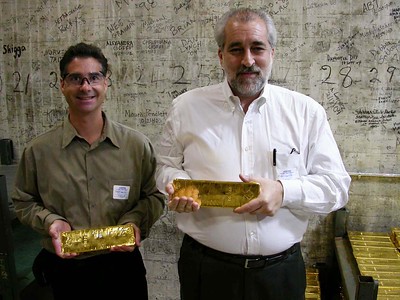 Fred Weinberg: Some of the coins that are in the 100 Greatest Error Coins book that Dave Camire and I
published about 12 years ago, I've never owned those. Some of them I still haven't seen, although I've seen
the photographs. So yes, there's always coins, whether you collect regular coins or any series within regular
coins…nobody's seen everything. There are some spectacular coins out there which I've seen pictures of that I
have not seen physically, that I would love to so that I could just have my eyes glaze over.
Fred Weinberg: Some of the coins that are in the 100 Greatest Error Coins book that Dave Camire and I
published about 12 years ago, I've never owned those. Some of them I still haven't seen, although I've seen
the photographs. So yes, there's always coins, whether you collect regular coins or any series within regular
coins…nobody's seen everything. There are some spectacular coins out there which I've seen pictures of that I
have not seen physically, that I would love to so that I could just have my eyes glaze over.
IMAGE: Dave Camire from NGC and Fred Weinberg. Photo was taken at the West Point Mint in 2009, in the Gold Cage room. -Editor
Greg Bennick: One thing that I appreciate about you and always have, and that I have heard people mention about you as well, is that any time we've ever talked at a show or on the phone, you have a little kid awe and fascination about you, about error coins. You still have that after all this time in the hobby. It's inspiring.
Fred Weinberg: Well thank you. And you know what, that's part of why I say I've never had a boring day in the coin business. I thought I would be doing this all my life. I literally did, up until a few years ago. And now there's a half a dozen reasons why I want to retire. But I've always loved coins, I've never been bored with them. And every day has been something new or something different. It's been a wonderful hobby that I turned into a profession. Not too many people can turn a hobby into a profession for 50 years.
Greg Bennick: It's true. Just in case people are curious, of those half a dozen reasons, are there any public reasons as to why you're retiring at this time, given that your energy and excitement about coins is still so high?
Fred Weinberg: There's no secrets. In no particular order, my reasons are, number one, this is my 50th year, which caused me to reevaluate everything. Number two, I'm going to be 72 in a couple of months. That's a reason to think about retiring. Number three, I've reconnected with my very first girlfriend from 50 years ago, and we're deeply in love. She happens to live in Asheville, North Carolina. So, between her living there and the virus, it's been hard. We try to see each other like every other month if possible. And, a lot of my decision was, my mother passed away at 96 about three years ago, and going through her house and all of her stuff made me realize -- this is maybe reason 6.5 -- as an error dealer, not just a coin dealer, but as an error dealer, I have so many strange things here in my office that if I passed away, there would be an incredible burden and stress on my daughter, and Kathy, my assistant, who's been with me for 37 or 38 years, to get rid of this stuff. They wouldn't know what to do. So between 50 year anniversary, turning 72, reconnecting with my first girlfriend, and also even a year ago, starting to think, you know what, do I really want to continue traveling to coin shows, where I'm going to a convention center in Florida, Chicago, Texas, whatever it is, where I don't know who's vaccinated? I don't know who's wearing a mask? In my seventies and eighties, do I want to expose myself to that, to sell another double struck penny?
It was a confluence of all of those things, plus the cherry on the pie being that in selling all this stuff, the coin market obviously is surprisingly strong right now. I don't think people would have thought it would have been as crazy as it's been for all of 2021 and even for 2022. So this hot market, because of all the money floating around in the economy, whether it's artwork or NFTs or rare coins or trophy coins, the coin market on almost every level is very very strong. This market will soften, whether it's two years from now or four years from now, and then it's going to take a couple of years of a dull flat market, and then it's going to take another couple of years for the market to start to work its way up, though in another couple of years the market will be hot again. I thought about it and I said, why not take advantage of an existing market that I know is good, rather than say, well, I'll wait for the next good market that may or may not appear until 8 to 10 years from now?
So, all of those reasons, Greg, are why I decided to retire and to basically sell most of my collectibles. In addition to all of my coins that Heritage has, they also have a collection of over 200 psychedelic rock posters from San Francisco, Avalon, and Fillmore that I started collecting in the early 1980s that to some degree, I'm more excited to see what they bring. Because I know what the coins will bring within a general range. But some of these posters have not been on the market in decades, and some of them are really good condition, and that's going to be sold in April, along with my coins, at the Central States show. I'm looking forward to seeing what these posters bring.
Greg Bennick: That's really exciting! Just out of curiosity, I never even thought to ask you, what other things do you collect and are you interested in?
Fred Weinberg: You mean as far as non-numismatic or non-coin things? I would say that the posters to a
degree. And if I had to think of what else, I just like collecting ephemera. Heritage also has a lot of stuff that I
had a lot of fun buying. Whether it's US Mint canvas bags, or very early US Mint reports, or letters from the
Treasury or letters from the US Mint talking about coins or different things. I had a book from the Philadelphia
mint that listed how much pay every person got in the 1870s and 1880s, including George Morgan. I liked
collecting what I call mint
memorabilia, things related to the US Mint that weren't necessarily the coins, but
they were the paperwork, or the canvas bags, or just unusual things like that. So that always kind of interested
me. And the posters. I love the posters all the time.
Greg Bennick: That's great. In terms of ephemera, my living room is literally piled with paper and ephemera from your collection that I've purchased recently. I bought a full run of Errorscope, a full run of The Penny, a full run of the Mint Error Collectors Bulletin, along with a couple hundred issues of Errorgram and Error Variety News. I'm going to spend the next few years reading through all that. The history of the hobby is fascinating.
Fred Weinberg: You'll probably run across two dealers named Phil Steiner and Mike Zimpfer. They did a book called Modern Mint Mistakes, which is kind of like Error Trends, telling how US coins are made, and showing coins. They were also very, very big dealers. And they made a major impact on the industry from the late ‘60s to the early to late ‘70s and then they kind of just disappeared. I know one of them was a schoolteacher, but I really don't know what happened to either one of them.
But Steiner and Zimpfer, came out with a good book on coins with a lot of pictures which everybody liked at the time.
Greg Bennick: I do know it. That book was immensely influential on me.
Fred Weinberg: I tell people, part of what's made the error hobby so big nowadays, is that when I started, all you could see was Collectors Clearinghouse, and of course that was just a couple pages in a newspaper with black and white pixelated pictures of an off center or double struck penny or something like that. But with computers and the internet now -- and this is what I honestly believe this really helped stimulate the error hobby in the last 20 years - you go to a Heritage or Stack's website and you look up a coin, and of course the images are huge, and in color, with data about what is being sold. The visual impact is just incredible.
So there's good and bad to that. The good news is, whether it's eBay or Heritage or even my website when I had my inventory up, major error coins made an incredible visual impact on computer screens, which really excited people. I got that feedback all the time. That's the good news and that helped expand the error hobby, and made people excited to buy coins. A mimeographed piece of paper with a black and white picture that you couldn't really tell what it looked like, didn't get people excited. Now you can see the spots, and a mark, and you can tell the luster, and you can see everything. So computers have really, really helped errors.
That's all the good news.
The bad news is basically the flip side of that. Because of computers, anybody that finds anything in
their pocket change or roll hunting searches that looks different, either they automatically assume it's an error
and worth a fortune, or, what I've been finding and it's been very frustrating just the last few years, is that they
start their own website. And they'll either take a damaged coin and say it's worth $1,000 or take a genuine
error coin and say it's worth $10,000, and they put it on their website. And I then dealers across the country,
get phone calls and emails that say things like, I have an off center penny. How close to $1000 will you pay
me? Because that's what somebody says it's worth on Etsy.
Or, Here's this coin that's been hit with a
hammer and Etsy says it's worth $10,000... what will you pay me?
And I have to explain to them that these
people put these things out there to get clicks or likes, and that an off center penny is worth $10, and that a
damaged coin is worth nothing.
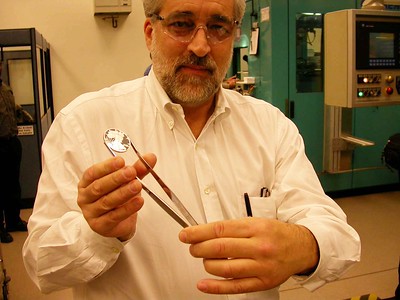 But it's enabled anybody to think, because of the bad information that's out there, that any coin that
they have that looks different, which they just found on Etsy for $5000 or $10,000, is worth that. And then they
get mad at you when you tell them it's damaged. I've seen the good and the bad and the plus and the minus of
the Internet. Overall, obviously it's a plus. And most dealers just ignore phone calls and emails from people
that find such things in their pocket change.
But it's enabled anybody to think, because of the bad information that's out there, that any coin that
they have that looks different, which they just found on Etsy for $5000 or $10,000, is worth that. And then they
get mad at you when you tell them it's damaged. I've seen the good and the bad and the plus and the minus of
the Internet. Overall, obviously it's a plus. And most dealers just ignore phone calls and emails from people
that find such things in their pocket change.
I've always taken the approach that it's my responsibility as an error dealer to let people know what
they have. In the old days, I would answer any email at least three times. In the original reply, Thank
you... based on your photographs your coin was gold plated.
They'd send me another one, asking why would
people do that? And I would reply, Well, people do that for this reason for that reason, out of boredom.
And
then maybe one other follow up question. In the last couple of years, I've had to come up with what I call a
canned reply, which basically says, Hello, thank you for your email.
However, due to all the quantity of emails
that we get every day, we can't reply to all of them individually. Please go to cointalk.com and post your
images there.
I mean I have to defer people, because people think that you have nothing better to do all day in your
business but to spend ten or twenty minutes talking about their coins. And when I keep on saying to them,
Email me a picture and I'm more than happy to try to tell you what it is
and they reply, Well, I don't have that
then I have to say, Well, then I can't help you.
They will reply with Well, but let me describe it to you…
but I
can't tell on the phone from their verbal description what it is. So then they sometimes offer to send the coin to
me. I don't have the time to do that. So the internet has been a little frustrating at times, but overall obviously
it's been a major benefit to the coin business and to errors.
For more information about CONECA, see:
https://conecaonline.org/
To read the earlier articles in this series, see:
Fred Weinberg Interview, Part One
(https://www.coinbooks.org/v25/esylum_v25n28a15.html)
Fred Weinberg Interview, Part Two
(https://www.coinbooks.org/v25/esylum_v25n29a17.html)
NUMISMAGRAM MEDAL SELECTIONS: JULY 2022
Jeremy Bostwick at Numismagram had a couple uploads of fresh medals and related exonumia to his website this month, and passed along some of these highlights. For all of the new items from this month, please visit numismagram.com/inventory. -Editor
102115 | SCOTLAND & FRANCE. François & Mary silver Jeton or Pattern Testoon. Dated 1553 (though the couple wouldn't be married until 1558) (28mm, 3.71 g, 10h). By N. Emery, likely in Paris. DILIGITE IVSTICIAM 1553, crowned FM (for François & Mary) monogram; sunburst to left and right / DELICTE DNI COR HVMILE, crowned coat-of-arms. MI 65/5; Burns vol. II, pp. 344-346 & pl. LXVI (fig. 916); Forrer II, pp. 15-16 (this type mentioned and illustrated); National Museum of Edinburgh 248; Lucien LaRiviere Coll. 285 = Marian Sinton Coll. 1683 = Robert William Cochran-Patrick Coll. 18 = London Coins 126, lot 559; Dundee Coll. –; McDonald Coll. –; Loch Ness Coll. –; NY Sale XXXII, lot 355 (which realized a total of $1,872 in January 2014). NGC EF-45. Lightly toned and fairly well struck for the type. For cert verification, please follow this link: https://www.ngccoin.com/certlookup/3748517-001/45/. An extremely rare and historically important type missing from most advanced Scottish collections. Apart from the specimen here, only two other examples of the type have been observed to have sold over the past two decades, the more recent being the specimen in the 2014 NY Sale. $1,985.
Mary was just six days old when her father, King James V of Scotland, died, leaving her as an infant queen. During her minority, the realm was administered by regents, with King Henri II of France proposing an alliance between France and Scotland through an eventual marriage of Mary to his son and heir, François. Given the enmity at that time with England for both France and Scotland, such an arrangement made sense, and Mary was sent to France for safety and upbringing in 1548. According to French tradition, when Mary was deemed to have come of age, she was able to formally ratify her marriage contract to François. This occurred in December 1553, though the wedding itself would not occur until 1558.
In the meantime, it is likely that this jeton, as well as the similar type (MI 66/6), sometimes referred to in the past as "pattern testoons" on account of their similarities to actual Scottish coinage of the time, was intended for usage within the royal household up until the marriage took place. Sadly for Mary, this marriage would be very short-lived, as François died just two years later. Mary would marry two other times before her forced abdication and then eventual execution under the orders of her first cousin once removed, Queen Elizabeth I of England. Incorrectly attributed on the holder as MI 66/6, as it is actually MI 65/5.
To read the complete item description, see:
102115 | SCOTLAND & FRANCE. François & Mary silver Jeton or Pattern Testoon.
(https://www.numismagram.com/product-page/102115)
102094 | GERMANY. Zellerfeld. Copper Rechenpfennig. Issued mid 17th century (25mm, 2.39 g, 4h). By H. Schlüter. CONSIDERA NOVISSIMA ET NON PECCABIS (consider thy end and sin no more), skull facing slightly right, surmounted by hour glass and with eye sockets pierced by worms; behind, scythe and spade crossed in saltire / HENNING SCHLUTER F B L M M Z Z, civic coat-of-arms. Neumann 31695; Appel 3416. About Uncirculated. Even brown surfaces, with some darker green around the devices. $465.
Rechenpfennigen, German for "accounting pennies," are similar to other tokens or jetons that could serve reckoning, gaming, or even semi-numismatic functions. In particular, the rechenpfennigen were made famous by their various manufacturers in Nürnberg (Nuremberg) from the mid-late 16th century to the early 18th century, with a host of themes used as subject matter. These topics included history, mythology, contemporary political affairs, and even satire. Though many were intended as aids in accounting and bookkeeping (with an accounting board and these tokens taking the place of an abacus or slide rule), they were also useful in other functions, such as in the world of gaming—as poker chips—or in commerce and monetary transactions—as a substitute for harder currency.
To read the complete item description, see:
102094 | GERMANY. Zellerfeld. Copper Rechenpfennig.
(https://www.numismagram.com/product-page/102094)
102066 | NETHERLANDS. Maastricht. Chapter of St. Servatius's Church lead Funeral Token (Begrafenisloodje). Dated 1828. Receipt for funeral expenses or as a funeral commemorative (28mm, 12.98 g, 12h). Skull and crossbones / ECCLESIÆ STI SERVATII, upright key. Edge: Some roughness, otherwise plain. Cf. Minard p. 196, 359 (cancellation punch on the reverse). Very Good. Graphite gray surfaces. A very rare and engaging type. $395.
Begrafenisloodje served multiple roles in the Low Countries during the 16th-19th centuries, acting as payment for gravediggers, pallbearers, or other funerary expenses, or acting as a commemorative for the funeral of the deceased—either to those attending the ceremonies or to the respective church in remembrance of the departed. Where they were utilized to indicate payment, a punch was generally placed upon one or both sides to act as a form of "cancellation" for the services rendered and payment received.
To read the complete item description, see:
102066 | NETHERLANDS. Maastricht. St. Servatius's Church lead Funeral Token.
(https://www.numismagram.com/product-page/102066)
102068 | NETHERLANDS. "Looking at Time 2" cast bronze Medal. Issued 1990 (71mm, 195.72 g, 12h). By the Auguralis group. Serpent coiled left around egg; outward-facing skull to left and right / kijken naar tijd 2 / panta rhei (p??ta ?e?, "everything flows," –adapted from Heraclitus), lemniscate shape, representing infinity. Edge: "4" stamped at the top. "De Beeldennar" (Jan/Feb 1991), p. 273. As Cast. Forest green surfaces, with great relief and some glossiness; date on egg erased, likely at the time of manufacture. Incredibly rare, with an output of just 5 pieces. $465.
From a series of Dutch modern art medals, somewhat similar to the former Society of Medalists series in the United States and BAMS series in the United Kingdom, this entrant from 1990 considers the idea of the passage of time—a very modern take on the concept of vanitas or a memento mori. The egg represents birth or the creation of life, while the serpent—that of its winding journey, and the skull—that of death or the end of the journey. Similarly, this concept is reiterated on the reverse, with a nod to the Heraclitus phrase, p??ta ?e?, or "everything flows." In the middle is a lemniscate shape, representing the seemingly endless, infinite, and somewhat entropic aspect of individual journeys in life.
To read the complete item description, see:
102068 | NETHERLANDS. "Looking at Time 2" cast bronze Medal.
(https://www.numismagram.com/product-page/102068)
102121 | RUSSIA & GERMANY. Our Mother of Perpetual Help enameled silver "Madonna" Taler.
Created circa late 19th century (41mm, 26.60 g, 12h). Representation of the famous icon, engraved and then enameled: Virgin Mary in colorful cloak, composed of blue (for motherhood) and red (for virginity), with head and eyes facing the viewer (her children on earth); the star on the top of her cloak indicates that she is the one who will lead us to Christ; she holds the Infant Christ, whose head is uplifted and looking off at a distance, with more adult-like features as a symbol of wisdom beyond His years; His green tunic symbolizes His humanity and creation, while the red sash around His waist symbolizes the Blood of Christ shed for our salvation, and the gold cloak is symbolic of the Resurrection; together, the colors of the garments are a statement of the Incarnation, Passion, Death, and Resurrection of Christ; His falling sandal informs us that He became human like us in all things but sin; showing his heel is from the promise of God in Genesis 3:15: I will put enmity between you and the woman, and between your seed and her seed; he shall bruise your head, and you shall bruise his heel;
around the Virgin Mary are small representations of the Archangels Michael (holding a lance, a pole with a sponge, and a vessel of vinegar; these prefigure scenes from Jesus's crucifixion) and Gabriel (holding a cross and nails; these prefigure scenes from Jesus's crucifixion); all four figures are identified with liturgical Greek abbreviations: MP T? (for the Virgin Mary), OP M and OP G (for the Archangels Michael and Gabriel), and IC XC (for Jesus Christ) / Reverse of a 1754 Taler from the Electorate of Bayern (Bavaria) in the name of Maximilian III Joseph: crowned Madonna seated facing among the clouds, holding scepter and Holy Infant. Edge: Floral pattern. Cf. Davenport 1952; cf. KM 500.2. Host coin: Extremely Fine. Deeply toned. Enameling: About Uncirculated. Very vibrant and unbroken, and expertly rendered. Pin back attached to reverse. An extremely rare, impressive, and wearable icon in miniature form. $1,095.
Associated with a 15th century Byzantine icon with an alleged Marian apparition, Our Mother of Perpetual Help is believed to have originated at the Keras Kardiotissas Monastery (???? ?e??? ?a?d??t?ssa?) in Crete, and has since been in Rome from 1499. It was canonically coronated in 1866 by Pius IX, and has since become one of the most popular icons within Roman Catholicism. Here, it has been expertly rendered, likely rather contemporaneously with the icon's coronation, on the obverse of the prior century's "Madonna Taler" from Bayern (Bavaria), with the fields smoothed, a light engraving created, and highly colorful enameling employed in order to evoke all of the hidden meaning throughout this heavily iconographic piece.
To read the complete item description, see:
102121 | RUSSIA & GERMANY. Our Mother of Perpetual Help enameled silver Icon.
(https://www.numismagram.com/product-page/102121)
SOTHEBY'S OFFERS BUZZ ALDRIN MEDALS
A number of important medals are being offered as part of Sotheby's sale of Apollo 11 Lunar Module Pilot Buzz Aldrin. -Editor
Sotheby's is thrilled to announce Buzz Aldrin: American Icon — the most important Space Exploration collection to come to market. The collection, consigned directly by Apollo 11 Lunar Module Pilot Buzz Aldrin, who has carefully preserved the materials since his missions, includes the most important mission flown artifacts from both the Gemini XII and Apollo 11 missions.
Highlights include the jacket Aldrin wore on his historic journey to the Moon and back on Apollo 11; the famous broken circuit breaker switch that nearly ended the lives of the Apollo 11 crew, and the felt-tipped pen that saved them; the famous Go Army, Beat Navy
banner Buzz brought with him on his Gemini XII spacewalk and exposed to the vacuum of space; complete mission-flown documents that were key to completing the mission, including the Apollo 11 LM Systems Activation Checklist, the LM Rendezvous Charts, Lunar Module and Command Module cue cards including the Apollo 11 EVA cue cards, the Rendezvous, Softsuit EVA, and Hardsuit EVA checklists from Gemini XII, as well as the Apollo 11 Summary Flight Plan and LM G&N Dictionary, flown lunar surface checklist and flight plan pages, flown flags, covers, and much more. Of note are the MTV VMA award statuette presented to Buzz, the Original Moonman,
his Presidential Medal of Freedom, and other important materials relating to his life leading up to becoming an astronaut, as well as materials relating to his life and accolades following his historic moonwalk.
Lot 56: New Frontier Congressional Gold Medal
We Came in Peace/For All Mankindalong outside, with crescent moon depicted next to globe (North America), with depictions of Lunar Module Eagle and the Mercury-Atlas 6. 18 ounces.
Housed in original United States Mint case, with blue felt lining inside and outside. Gold-colored rim to case. Case comes in blue cardboard box of the United States Mint, barcode 022/704785052703. Obverse sculptor: Phebe Hemphill, and designer: Joel Iskowitz. Reverse sculptor: Don Everhart, and designer: Joel Iskowitz. Minted in Philadelphia.
To read the complete lot description, see:
Buzz Aldrin's New Frontier Congressional Gold Medal
(https://www.sothebys.com/en/buy/auction/2022/buzz-aldrin-american-icon/buzz-aldrins-new-frontier-congressional-gold-medal)
Lot 58: National Geographic Society Hubbard Medal
To read the complete lot description, see:
Buzz Aldrin's 1970 National Geographic Society Hubbard Medal
(https://www.sothebys.com/en/buy/auction/2022/buzz-aldrin-american-icon/buzz-aldrins-1970-national-geographic-society)
Lot 60: NASA Exceptional Service Medal
Awarded to Buzz Aldrin on November 22, 1965, seven days after Gemini XII's reentry on November 15, 1966, the NASA Exceptional Service Medal was given to Buzz and Gemini XII commander Jim Lovell by President Lyndon Johnson at the LBJ Ranch in central Texas.
To read the complete lot description, see:
Buzz Aldrin's NASA Exceptional Service Medal
(https://www.sothebys.com/en/buy/auction/2022/buzz-aldrin-american-icon/buzz-aldrins-nasa-exceptional-service-medal)
Lot 68: Tsiolkovsky Medal
This medal honors the memory of Konstantin E. Tsiolkovsky (1857-1935), the Russian/Soviet rocket scientist and one of the founding fathers of modern rocketry. Originally awarded only to members of the Soviet space program, Tsiolkovsky medals were sometimes given as diplomatic gifts from high government or space program officials to their international peers.
To read the complete lot description, see:
Buzz Aldrin's Tsiolkovsky Medal and Accompanying Certificate
(https://www.sothebys.com/en/buy/auction/2022/buzz-aldrin-american-icon/buzz-aldrins-tsiolkovsky-medal-and-accompanying)
For more information, see:
Buzz Aldrin: American Icon
(https://www.sothebys.com/en/buy/auction/2022/buzz-aldrin-american-icon)
ARCHIVES INTERNATIONAL AUCTION 78
Here is the announcement for the July 27, 2022 sale by Archives International Auctions. -Editor
ARCHIVES INTERNATIONAL AUCTIONS OFFERS HISTORIC U.S., CHINESE & WORLD BANKNOTES, AND SCRIPOPHILY COLLECTION ON JULY 27, 2022
The auction will be held by Archives International Auctions at their offices in River Edge, N.J.
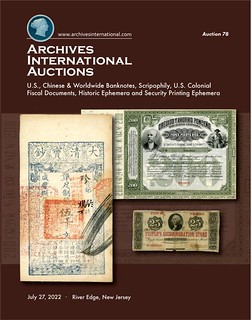 The July 27, 2022, Auction 78, by Archives International Auctions will feature of 812 lots of rare and desirable U.S., Chinese & World Banknotes, Scripophily, Historic Financial Ephemera, and Security Printing Ephemera. The auction is highlighted by 123 lots of Chinese banknotes and scripophily, a majority of the notes being from an old-time collection having never been offered previously at auction. Also included are over 370 lots of Worldwide banknotes with many rarities present; 31 lots of U.S. Colonial banknotes and fiscal documents, U.S. Obsolete banknotes, depression scrip, Confederate banknotes and related items; 57 lots of Historic Ephemera and Security Printing Ephemera with additional lots of checks drafts and exchanges; 12 lots of Philatelic material including Souvenir Cards by ABNC, world stamps and postal history; and, ending with 211 lots of U.S. and World Scripophily.
The July 27, 2022, Auction 78, by Archives International Auctions will feature of 812 lots of rare and desirable U.S., Chinese & World Banknotes, Scripophily, Historic Financial Ephemera, and Security Printing Ephemera. The auction is highlighted by 123 lots of Chinese banknotes and scripophily, a majority of the notes being from an old-time collection having never been offered previously at auction. Also included are over 370 lots of Worldwide banknotes with many rarities present; 31 lots of U.S. Colonial banknotes and fiscal documents, U.S. Obsolete banknotes, depression scrip, Confederate banknotes and related items; 57 lots of Historic Ephemera and Security Printing Ephemera with additional lots of checks drafts and exchanges; 12 lots of Philatelic material including Souvenir Cards by ABNC, world stamps and postal history; and, ending with 211 lots of U.S. and World Scripophily.
We are privileged to offer an incredible assortment of China and Worldwide banknotes as well as a large assortment of U.S. and World banknotes and scripophily
, stated Dr. Robert Schwartz, President of Archives International Auctions. Included in the upcoming auction are desirable and rarely seen numismatic items that will enhance the collections of every level of collector and dealer
.
The auction begins with 496 lots of World banknotes highlighted by an amazing Chinese Empire, Ch'ing Dynasty, 1858, High-grade 5000 Cash Issue banknote offered for the first time at auction; a Madeira Islands, ND (late 1860-1900), 100 Reis, Denomination, P-Unlisted, Issued Leather Token; a Puerto Rico, Banco Espanol De Puerto Rico, ND (1894) 5 Pesos, "Top Pop" Specimen Banknote Rarity; and a wide assortment of individual desirable notes to small group lots; and hundreds of other notes that are sure to attract everyone from the beginning to advanced collector.
U.S. currency and fiscal documents are highlighted by a U.S. Colonial, Maryland, Principio Company 1773 Colonial Bill of Exchange for the account of Kingsbury Furnace. The Principio Company formed as a joint stock company in 1720 to take advantage of new laws passed in Maryland to encourage the early iron industry. By 1729, one of the partners was Augustine Washington, father of George Washington; U.S. Obsolete banknotes are highlighted by a Vermont, Bank of Burlington, ca.1830's Obsolete Banknote Proof from the Silver City Collection; a Waukesha, Wisconsin, People's Accommodation Store, 1862 Obsolete Scrip Note; and numerous additional obsolete notes. Historic ephemera is highlighted by 4 different Southern U.S. Slave Trade documents, circa 1827 to 1863; numerous Civil War military related documents; 2 different early Texas Land Grants, one signed by Texas Governor Elisha M. Pease; and, various other historic documents.
Security Printing Ephemera includes 32 lots of various security printed production and advertising items highlighted by an American Bank Note Co, 1929 (ND ca.1960s-70s), TYVEK Polymer Test Note With essay U.S. Federal Seals Used on FRN banknotes. A wide variety of security printer items are included in this auction that cover every aspect of Intaglio printing offered by both U.S. and European printers that is sure to attract the attention of the advanced collector interested in the development and history of Security printing in the world.
The auction ends with 211 lots of U.S. & World Bonds and Shares. Some of the many highlights include 2 different Berkshire Hathaway Inc., 1996 Specimen Stock Certificates with Warren Buffett Facsimile Signature; a Nasdaq Stock Market, Inc. 2001 Specimen Stock Certificate Rarity; a very attractive Wells Fargo and Company, ca.1900 to 1910, Specimen Stock Certificate; an Amazon.Com, Inc., 2001, Specimen Stock Certificate rarity; a Puerto Rico, Credito y Ahorro Ponceno S.A., 1897, 200 Pesos Specimen Bond rarity; a Florida, Southern Inland Navigation & Improvement Co., 1871 I/U Bond; a Hawaiian Electric Co., 1924. Specimen Bond; and, dozens of other rare and desirable bonds and shares with many offered for the first time at auction including the topics of banking, railroads, mining, Worldwide and additional subjects with many rare and desirable items offered.
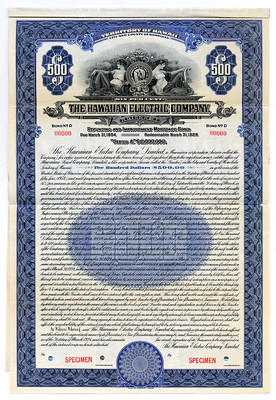 Previews will be limited and by appointment only and we will be observing strict safety precautions including the wearing of masks and observing social distancing to protect our team as well as our guests. We will do our best to accommodate anyone who desires additional information and photographs. For questions, please call 201-944-4800 or email
info@archivesinternational.com.
Previews will be limited and by appointment only and we will be observing strict safety precautions including the wearing of masks and observing social distancing to protect our team as well as our guests. We will do our best to accommodate anyone who desires additional information and photographs. For questions, please call 201-944-4800 or email
info@archivesinternational.com.
The online catalog for the Wednesday, July 27th, 2022 auction is on Archives International Auctions' website and can be viewed via the Archives International live Auction 78 bidding platform. It can also be viewed as a Sale 78 Virtual Catalog or downloadable Sale 78.pdf on their website. To pre-register for Live Internet Bidding, log on to the Archives International Auctions website, at www.ArchivesInternational.com.
Archives International is now working on their Fall 2022 auctions with Auction #79 tentatively scheduled for early September and are seeking quality consignments for future auctions or outright purchase including U.S. and worldwide banknotes, coins, stocks, bonds, stamps, postal history, historic ephemera, and autographs.
To sell or consign one piece or an entire collection, please call AIA at (201) 944-4800; or email them at info@archivesinternational.com.
You may also write to Archives International Auctions, at 1060 Main Street, Suite 202, River Edge, NJ 07661, U.S.A. To learn more about Archives International Auctions and the auction planned for July 27th, 2022 auction, log on to www.ArchivesInternational.com.
For the virtual catalog, see:
https://archivesinternational.auctioneersvault.com/catalog/Archivessale78/index.html
For a .pdf catalog, see:
https://archivesinternational.auctioneersvault.com/catalog/Archivessale78/AIAAuction78.pdf
STACK'S BOWERS TO OFFER VOLCKER COLLECTION
This press release describes Stack's Bowers Galleries' upcoming offering of the Paul A. Volcker, Jr. collection. -Editor
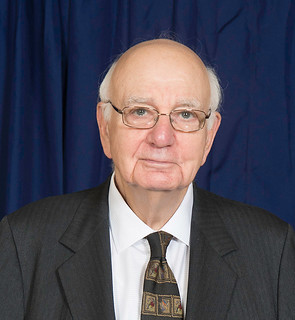 In a career spanning nearly six decades including public service under five U.S. presidents, Paul
A. Volcker, Jr. worked for private and public firms as an esteemed economist and helped shape the nation's
economic policies. In these roles he received numerous awards, medals, and commendations from entities both
domestic and foreign, which Stack's Bowers Galleries is proud to offer at auction to private collectors and museums.
In addition to the awards, Volcker collected a small group of numismatic coins that will also be offered in the
August sale.
In a career spanning nearly six decades including public service under five U.S. presidents, Paul
A. Volcker, Jr. worked for private and public firms as an esteemed economist and helped shape the nation's
economic policies. In these roles he received numerous awards, medals, and commendations from entities both
domestic and foreign, which Stack's Bowers Galleries is proud to offer at auction to private collectors and museums.
In addition to the awards, Volcker collected a small group of numismatic coins that will also be offered in the
August sale.
Beginning in 1952, Volcker joined the staff of the Federal Reserve Bank of New York as a full-time economist. After five years there, he moved on to Chase Manhattan Bank where he served as a financial economist. In 1962 Volcker joined the U.S. Treasury Department as Director of Financial Analysis and, a year later, was appointed Deputy Under Secretary for Monetary Affairs. He returned to Chase Manhattan Bank as Vice President and Director of Planning in 1965.
President Richard Nixon appointed Volcker as Under Secretary of the Treasury for International Monetary Affairs, a position he held for five years. During that tenure, he was instrumental in eliminating the convertibility of gold to the dollar, ending the Bretton Woods system which had been in place for just over a quarter century. Following his work at the Treasury Department, Volcker became President of the Federal Reserve Bank of New York, a position he held from 1975 to 1979.
In July 1979, President Jimmy Carter nominated Paul Volcker to serve as Chairman of the Board of Governors of the Federal Reserve System. He was confirmed by the Senate the following month and was re-nominated four years later by President Ronald Reagan. Under Volcker's leadership, the Federal Reserve helped curb inflation, which had risen to nearly 15% in March 1980 – three years later it had fallen below 3%. To fight inflation, the Fed under Volcker raised the federal funds rate, which resulted in extremely high interest rates during the early 1980s.
Paul Volcker left the Federal Reserve in 1987 and became Chairman of Wolfensohn & Co., a prominent New York investment banking firm. Throughout the 1990s he remained active, serving as the chairman of various committees and task forces, among them the Independent Committee of Eminent Persons (Volcker Commission), the IFRS Foundation, and the Group of Thirty.
Under President Barack Obama, Volcker was selected to head the President's Economic Recovery Advisory Board. He was reported to be Obama's choice for Secretary of the Treasury, but as he was over 80 by then, he was considered too old. In 2013, Volcker founded the Volcker Alliance, a nonprofit organization to address the challenge of effective execution of public policies and to rebuild public trust in government.
Highlights of the collection to be offered in the August auction include Volcker's gold Treasury Department Service medal; a massive gold Benjamin F. Fairless medal certified by NGC as MS-67; a Nelson A. Rockefeller Public Service Award medal in gold and a Harry S. Truman Foundation Good Neighbor Award gold medal.
The collection of awards and medals presented to Paul A. Volcker Jr, former Chair of the Federal Reserve under presidents Jimmy Carter and Ronald Reagan will be offered Monday, August 22, 2022 as part of the Global Showcase Auction, presented by Stack's Bowers Galleries, official auction partner of the American Numismatic Association World's Fair of Money. For more information call 800-458-4646, email info@stacksbowers.com, or visit the firm's website at StacksBowers.com.
THE BOOK BAZARRE
NUMISMATIC NUGGETS: JULY 24, 2022
Here's a selection of interesting or unusual items I came across in the marketplace this week. Tell us what you think of some of these. -Editor
Henry VI, King of England and France (1422-53), Angelot d'Or, St. Lô Mint, minted from 24th May 1427, Angel Gabriel with outstretched wings resting hands on the shields of France and England, mintmark fleur de lis both sides, reads HENRICVS FRANCORV ET ANGLIE REX. Rev, Latin cross, lis to left, lion to right, legend surrounds XPC VINCIT XPC REGNAT XPC IMPERAT, 2.32g (S.8165; Elias.277 RR; Schneider 134; AGC 394A dies 2/a).
Offered by Baldwin's. -Editor
To read the complete lot description, see:
HENRY VI ANGELOT D'OR (1422-53)
(https://www.baldwin.co.uk/product/henry-vi-angelot-dor-1422-53/#tab-description)
1863 Atlantic Garden, New York Civil War Merchant Token - "Free Admission"
Public theater admission tokens and passes have a long tradition in numismatics. -Editor
To read the complete lot description, see:
Lot 358: 1863 Atlantic Garden, New York Civil War Merchant Token - "Free Admission"
(https://www.invaluable.com/auction-lot/1863-Atlantic-Garden,-New-York-Civil-War-Merchant-358-c-B7444398BA)
MEDAL REGIONAL BRONZE - THE CHARENTAISE - ERNESTA ROBERT - MERIGNAC DECO SIGNED
Size :
6.4 cm = 2 33/64 inch X 5.1 cm = 2 1/64 inch
From an eBay seller in Portugal. -Editor
To read the complete lot description, see:
MEDAL REGIONAL BRONZE - THE CHARENTAISE - ERNESTA ROBERT - MERIGNAC DECO SIGNED
(https://www.ebay.com/itm/165533050224)
1964 Austria. 50 Schillings. Proof. Winter Olympics Innsbruck Commemorative. Silver. KM-2896. 34mm. 20g. The obverse features the denomination within beaded circle, small spray of leaves below, 3/4 circle of shields surrounding. Engraver: Edwin Grienauer. The reverse features Ski jumper facing left, Olympic logo above. Engraver: Arnold Hartig. Edge: Lettered FUENFZIG SCHILLING
. Mint: Vienna, Austria.
From the American Numismatic Association Money Museum Store on eBay. -Editor
To read the complete lot description, see:
1964 Austria. 50 Schillings. Proof. Winter Olympics Innsbruck Commemorative.
(https://www.ebay.com/itm/314071617767)
Beautiful unusual Bronze medal regional airlines
MEASURES - 7.50/8 CM
WEIGHT- 297 GRS
From a different eBay seller elsewhere in Portugal. Nice obverse design. -Editor
To read the complete lot description, see:
Beautiful unusual Bronze medal regional airlines
(https://www.ebay.com/itm/385010812079)
Chinese Cash Coin ?
Countermarked "NANKING INN"
Note: This "cash coin" could potentially be from another country that used square-holed coins: Korea, Japan, Vietnam, etc.
Brunk N-29.
Issuer: Nanking Inn
Business/Profession: Hotel, Inn, and/or Restaurant
From Bob Merchant's eBay offerings. -Editor
To read the complete lot description, see:
Chinese Cash Coin, Counterstamp "NANKING INN" (Hotel, Inn, and/or Restaurant)
(https://www.ebay.com/itm/134175043251)
WAYNE'S NUMISMATIC DIARY: JULY 24, 2022
Mike Packard was the host for the July 19, 2022 dinner of my Northern Virginia Numismatic Social group Nummis Nova. He'd made reservations at The Esposito's in Fairfax, a nice little Italian restaurant we'd visited several times before.
I saw Robert Hoppensteadt in the parking lot. After texting my wife I headed inside where a group of tables in our usual corner was waiting. In addition to myself, Mike and Robert, the night's attendees included members Daryl Haynor, Roger Burdette, Steve Bishop, Dave Schenkman, Eric Schena, Jon Radel, Tom Kays, Julian Leidman and my guest, 16-year-old Jonas Denenberg. Jonas is a member of the Fairfax Coin Club and already a busy coin dealer traveling to shows all across the country.
I hadn't seen Jonas since his latest growth spurt, and he towered over me at six feet plus. We sat together at an end of the table near Mike and Roger. Here's my photo of the group.
Clockwise from left: Jonas Denenberg, Mike Packard, Robert Hoppensteadt, Eric Schena. Dave Schenkman, Julian Leidman, Daryl Haynor, Tom Kays, Jon Radel, Steve Bishop, and Roger Burdette.
Numismatic Ephemera
I passed around a thick binder from my numismatic ephemera collection, containing items related to U.S. coinage laws along with some early U.S. Mint Reports. The highlight (for me anyway) is an April 17, 1792 printing of An Act Establishing a Mint.
Here's a printing of a 1816 Act to Enable His Majesty to authorize the Exportation of the Machinery necessary for erecting a Mint in the United States of America, and an 1817 Report of the Director of the Mint.
Here's an 1867 Report of the Director of the Mint and an 1878 essay on American Coinage and Currency by Durbin Ward.
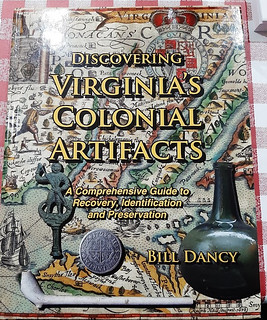 Virginia's Colonial Artifacts Book
Virginia's Colonial Artifacts Book
Tom shared his copy of Bill Dancy's 2017 book Discovering Virginia's Colonial Artifacts. See the earlier E-Sylum article for ordering information. I don't have this one, but having seen it I'd recommend it for anyone with an interest in colonial coinage and all foreign coins that circulated in the U.S. prior to 1857.
To read the earlier E-Sylum article, see:
NEW BOOK: DISCOVERING VIRGINIA'S COLONIAL ARTIFACTS
(https://www.coinbooks.org/v20/esylum_v20n42a04.html)
1877 Double Eagle Discovery Coin
Roger Burdette displayed an unusual 1877 Double Eagle; more about this later.
Unusual Denominations Dave Schenkman passed around a couple of fascinating items with unusual denominations.
Dave writes:
"During the 1830s Glenn Springs, South Carolina was well known for its healing mineral springs. Osmyn B. Irvine, who issued the note, was a physician who probably was involved in the spa. 37 1/2 cents (three bits) is a scarce denomination, and with it expressed in Roman numerals it is even scarcer."
Dave writes:
"The token is from Peña Station, Texas. It was issued by Lazaro P. Peña, a merchant who owned nearly two thousand acres of land in the area. The token is 21mm and struck in copper-nickel. It was struck by the Heidemann Manufacturing Company, a well-known San Antonio die sinking firm that was responsible for many of the attractive Texas saloon tokens issued during the late nineteenth century."
Two unusual and rarely seen pieces - reason alone to attend these events, but as usual, there's more.
Steve's Latest Acquisitions
Steve Bishop writes:
"In addition to a Roosevelt plaque, I brought a couple of Russian 5 kopeck pieces from Paul's reoverstriking program of 1797. Most of these were dated 1793, even though they were struck in 1797 over 1796 10 kopeck pieces of the Cipher series of Catherine the Great. The Cipher series was Catherine's attempt to change the monetary standard so that a 5 kopeck piece became a 10 kopeck piece. After Catherine's death, her successor, Paul I, reversed the decision and recoined most of the Cipher series back according to the original monetary standard. He dated them 1793 in order to blame the failed attempt on Catherine. As a result, original strikings of the Cipher series are very rare.
"The two pieces I brought are both dated 1793, with one having the mintmark EM (Ekaterinberg), and the other bearing no mintmark. The EM variety is scarce, but the most plentiful of the 5 kopeck reoverstrikings. The one lacking a mintmark, however, is another story. This variety was struck at Moscow/Nizhny Novgorad. The Grand Duke Michaelovitch, the owner of the largest collection of Russian coinage, now in the Hermitage Museum, knew of only two examples. If genuine (not one in which the mintmark has been removed), this would be the third known example."
Tom's Notes from the Far end of the Table
Tom Kays provided this writeup and photos. Thanks!
Notes from the far end of the Table – Tom Kays
Adding to what Wayne said, returning to The Espositos, a fine old Italian family restaurant in Fairfax, the twelve of us knew what to order, anticipating a grand feast of Neapolitan-inspired, authentic Italian cuisine. We employ an impromptu, early elementary school ‘Show and Tell' style of passing obscure numismatic goods clockwise, giving the story to the person to our left, who generally does not tell all the folks down-the-line what they just heard about what they hold. Some items pass from the far side of the table with no explanation as to what they are or why they are being shared in this broken telephone
game of ‘what did I just see?'
I have learned to snap fuzzy, low light pics of whatever I am handed as an aid to memory, to be able to report to you, all the highlights of what a dozen seasoned numismatists bring to dinner to impress other numismatic luminaries. What would you bring and what stories might you share about noteworthy items in your collection? Could you keep intriguing numismatic dinner conversations going to your left, right and cross table all the while stuffing yourself with fine food and fine wine? Some diners will send Wayne good images of their items with their full and true provenance the next day, so that you may see accurate, well-documented, high-resolution images and descriptions of some of the dinner coins in the E-Sylum. Yet interspersed with those sunlit rarities may be fuzzy, Lock Ness Monster-quality pics of numismatic oddities and their half-remembered legends, to keep you on your toes. Take with a grain of salt, any story of an item photographed by candlelight, on a red-checkered tablecloth, when reading further.
I saw a November 23rd, 1861 Corporation of Winchester 12 1/2 Cent (One Bit) Note with beehive vignette only to be surpassed in coolness by an 1838 South Carolina, Glenn Springs, 37 1/2 Cents (Three Bit) Note with denomination given in ‘Federal Cents' but written in English, Arabic numerals, and large Roman numerals in multiple places about the note.
Next came an 1876 Indian Head Cent in a modern PCGS MS64 BR with gold CAC sticker, only to be challenged by a 1909 Indian Head Cent in an ancient, PCGS MS65RB holder. Just to show that not all 150-year-old copper coins are shades of brown or red. Once in a great while a rainbow appears.
Then came a large 19th Amendment Centennial (1920 – 2020) Medal with jailed suffragette Where we were but a handful,
fecit by EMW (Eva-Maria Wohn), that shows the Statue of Liberty in an ambiguously similar situation.
Also seen in passing were an 1891 one real token from Lazaro P. Peña, Peña Station, Texas, and a 1797 16 Stars, Small Eagle Dime in NGC VF20, and a 1793 (No Mint Mark) Russian five kopeks struck over and back-dated from a 1796 ten kopeks (the result of a real family squabble).
A nearly life-size, 1914 bronze Teddy Roosevelt Plaque by J. Jusky covered the table along with (not pictured) the first of many binders from the Wayne K. Homren Numismatic Library Ephemera Files, Relating to U. S. Coinage Laws and Mint Reports with original items starting with a copy of U.S. Mint Director Elias Boudinot's Mint Report of 1797, the U.S. Mint Report of 1817, and many subsequent items of great historical interest.
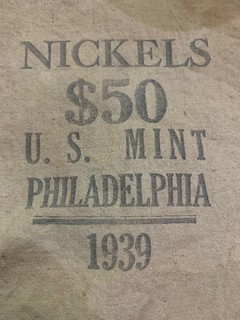 Julian brought a ‘nickel bag' labeled
Julian brought a ‘nickel bag' labeled Nickels $50 U.S. Mint Philadelphia 1939
that he bought still holding one of its original 1939 nickels.
Finally seen was a small, mahogany relic case of oddments, including an octagonal 1852 large cent (possibly used as a recognition token for the Underground Railroad?), an old Bolen electrotype of the 1787 ‘Indian and Eagle on Globe' New York copper, a New Ark Church neo-ancient bronze,
an 1815 bust quarter dollar, various Spain/Spanish Colonial 2/4/8 reales from Lima, Mexico, Potosi, and Cadiz, (one with a counterstamp advertising Kunkel's Opera Troupe), and a Mary Queen of Scots, billion bawbee (before marriage, circa 1542).
The highlight of the evening was an 1877 Philadelphia Mint ‘Double Eagle,' original hub discovery coin with a copy of correspondence from James Pollock, Superintendent of the Philadelphia Mint to H. R. Linderman, Director of the Mint in 1877, complaining about slight changes in the radius of dies engraved by ‘young Mr. Barber' that affect stacking of the 1877 San Francisco and Carson City double eagles, to be not as stackable as were the 1876 coins. Pollock suggests Mr. Morgan be assigned to the engraver's office as a replacement for Mr. Barber, and that trial pieces and new dies be prepared and sent for stacking tests at Philadelphia.
These Nummis Nova dinners are a joy to do, and only major conflicting events like the ANA World's Fair of Money are prestigious enough competition for us to skip a dinner, as we will miss August 2022. No telling what numismatic treasures will be floating around in September at whatever new dinner venue is chosen when Nummis Nova dinners resume.
'Til Next Time
Thanks, everyone. Dave, Tom, Steve and Daryl provided images, and several folks reviewed and helped edit this report. As Tom noted, we decided to skip next month due to conflicts with the ANA. It was another fun evening of the best parts of numismatics - great coins and great friends, not to mention the food and drink and general camaraderie.
NERO'S PORT OF OSTIA SESTERTIUS
In a Stack's Bowers blog article, Jeremy Bostwick discusses the Port of Ostia Sestertius of Nero. -Editor
Given its larger-format size (corresponding to a diameter between that of a standard Half Dollar and Silver Dollar), the Roman Sestertius was always the prime candidate for more artistically ambitious designs. This broad canvas allowed the celator great leverage to pack as much detail as possible onto the flan—an aspect that was essentially impossible upon other denominations given their smaller diameters. As such, it made the Sestertius the perfect vehicle for commemorative events. Given the highly propagandizing nature of some Roman coinage, it presented an opportunity for an emperor to promote various events and locales that would garner even more support from the populace.
One such event was the massive works project of constructing the Port of Ostia, a city that (at the time) connected the inland city of Rome with the Tyrrhenian Sea via the Tiber River. As the Roman Empire continued to grow in power and influence in the decades following the death of Augustus, the need for easy access to the sea was obvious. As such, work commenced under Claudius in A.D. 42. Rather interestingly, one of the pleasure galleys
of his predecessor, Caligula, was scuttled and filled with cement, with a lighthouse and statue dedicated to Neptune constructed upon it. Though a finishing date is not known, numismatics can point to a probable answer, as it was under Nero, the successor of Claudius, that the magnificent port received a depiction monetarily that would solidify it in the mind of not just all Romans, but collectors to this day.
The Port of Ostia Sestertius of Nero, issued circa A.D. 64, presents busts of the emperor facing either left or right on the obverse, and with a very detailed bird's eye view of the recently constructed port upon the reverse. From here, the viewer is instantly transferred to that time and place, with seven ships under sail within the harbor, and the aforementioned lighthouse and statue prominently placed near the top. Near the bottom, a reclining male figure—a personification of the Tiber River itself—holds firm to a rudder. All around, a crescent-shaped pier envelops the harbor, with numerous breakwaters seen on each side. Though history seemingly lacks renditions of this consequential public works project, the Sestertii issued under Nero offer a tremendous glimpse into its look and feel. As the centuries progressed, however, the port's usage began to diminish, with silting from the Tiber causing the area to become a damp breeding ground for diseases—not entirely that different from the declining empire herself.
Our upcoming Summer 2022 Global Showcase Auction will feature one such Port of Ostia Sestertius in a condition that is generally far superior to those normally encountered in the marketplace. Graded by NGC as VF Strike 5/5, Surface 3/5,
and with the ever-important Fine Style
designation, this issue presents a captivating rendering of the port along with a solid portrait of the rather infamous emperor. Furthering its appeal is the fact that this elegant specimen has been off the market for some 40 years, last appearing in a Robert Myers fixed price list in 1981. As such, we expect this coin to generate great interest, as it is a true touchstone to the past.
To read the complete article, see:
THE PORT OF OSTIA AND ITS NUMISMATIC DEPICTION UNDER NERO
(https://stacksbowers.com/the-port-of-ostia-and-its-numismatic-depiction-under-nero/)
SNAKES ON ANCIENT COINS
In his latest CoinWeek article, Mike Markowitz examines snakes on ancient coins - even snakes with beards. Here's an excerpt - be sure to read the complete article online. -Editor
MOVING SILENTLY AND mysteriously without legs, the snake has always held a powerful grip on the human imagination. The snake is a complex and multi-dimensional symbol in Western art. At various times and places, it has represented fertility, rebirth, healing, and guardianship, as well as the forces of darkness and evil. In the CoinArchives Pro database, which records almost two million ancient coin auction sales that took place during the last two decades, a recent search for the term snake
produced 36,918 hits. The synonym serpent
produced 39,759 hits. That's nothing to hiss at.
Snakes with Beards
Aelian) in his book De Natura Animalium explained that the beard showed that the creature was male. Lacking external sex organs, as well as legs, snakes present no visible indication of gender. A bearded snake appears on the reverse of a little electrum hekte of Mytilene on the Aegean island of Lesbos, c. 357-326 BCE.
Baby Herakles
The birth of Herakles, son of Zeus and Alkmene, enraged Zeus' wife Hera, who tried to kill the infant by sending two serpents to strangle the sleeping baby in his crib. The following morning, the nurse discovered Herakles playing with the serpents' lifeless bodies: he had strangled one in each hand.
This striking image even has a name: Herakliskos drakonopnigon (Little Herakles the Serpent Strangler
). It appears on the coins of many Greek cities, including Kroton in southern Italy; Rhodes; Samos; Kyzikos; and notably Thebes, on a unique gold drachma dated to 395 BCE, symbolizing the Theban struggle against Sparta.
In 1783, when Benjamin Franklin, American ambassador to France, commissioned a silver medallion celebrating victory over Britain, the image of the infant killer of snakes was chosen to symbolize America.
To read the complete article, see:
Snakes on Ancient Coins
(https://coinweek.com/ancient-coins/snakes-on-ancient-coins/)
THE HISTORY OF UKRAINE'S MONEY
National Numismatic Collection Curator Ellen Feingold published an article in Smithsonian Magazine about how medieval money shaped Ukraine's modern identity. Here's an excerpt. -Editor
Before the February 2022 Russian invasion of Ukraine, few outside of the country took note of the trident symbol at the center of Ukraine's national emblem. But in the days following the invasion, the trident was beamed around the world, appearing in the backdrops at press conferences and embossed on the clothing worn by the nation's leaders and soldiers.
The origins of the ubiquitous trident, or tryzub, lie in the medieval period when the city of Kyiv was the seat of power of a state known as Kyivan Rus'. Encompassing all of modern-day Ukraine, Belarus and parts of Russia, this vast territory was ruled by the Rurik dynasty. As the dynasty's symbol, the trident appeared on the first coins minted in Kyiv around the turn of the 11th century. These coins—as well as other types of medieval money—have become a central part of how modern Ukraine tells its national story and displays its national identity.
As the curator of the National Numismatic Collection, I oversee an expansive collection of monetary objects that reflect the world of yesterday and today. Each new object I acquire enables me to tell a new story and to reveal histories already contained within the collection. About a month after the Russian invasion, I came across the new Peace for Ukraine
zero-euro note, which features a dove in flight, with a flag and olive branch clasped in its beak. The dove is a common symbol, but it was striking to see it at the center of the design of a euro banknote, decorated in Ukraine's national colors of blue and gold.
A German aid association produced the note to raise funds in support of Ukrainian children. While the note is not legal tender, it is a worthy addition to the Smithsonian's numismatic collection because its creators used the design of money as a canvas to aptly capture what is at stake in the current war—Ukraine's national sovereignty along with its freedom to join the European Union. Collecting this note initiated an unexpected journey through the vault of the National Numismatic Collection and into Ukraine's complex history.
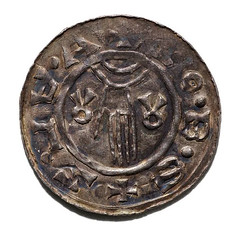 During the late 10th century, Kyiv produced its first coins issued under the authority of Volodymyr I, the legendary ruler of Kyivan Rus' who is known for his conversion to Christianity and the subsequent spread of the religion throughout the region. Volodymyr I modeled his delicately engraved gold zlatnyk coin after contemporary Byzantine nomisma coins issued by the Byzantine emperors Basil II and Constantine VIII, but he altered the design to feature his own portrait. He also included the trident symbol as a representation of his rule and the Viking dynasty he descended from. Volodymyr's gold coins together with his silver coins, which also featured the trident, were a powerful assertion of his authority and the state that he ruled.
During the late 10th century, Kyiv produced its first coins issued under the authority of Volodymyr I, the legendary ruler of Kyivan Rus' who is known for his conversion to Christianity and the subsequent spread of the religion throughout the region. Volodymyr I modeled his delicately engraved gold zlatnyk coin after contemporary Byzantine nomisma coins issued by the Byzantine emperors Basil II and Constantine VIII, but he altered the design to feature his own portrait. He also included the trident symbol as a representation of his rule and the Viking dynasty he descended from. Volodymyr's gold coins together with his silver coins, which also featured the trident, were a powerful assertion of his authority and the state that he ruled.
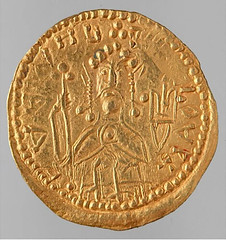 Silversmiths in Kyiv also produced ingots called hryvnia in a distinctive hexagonal shape, distinguishing them from the long and thin silver ingots produced in Novgorod and from others made in cities across the region. The word hryvnia is derived from metal ornaments that were worn around the neck and also used as a measure of weight.
Silversmiths in Kyiv also produced ingots called hryvnia in a distinctive hexagonal shape, distinguishing them from the long and thin silver ingots produced in Novgorod and from others made in cities across the region. The word hryvnia is derived from metal ornaments that were worn around the neck and also used as a measure of weight.
The collapse of Kyivan Rus' during the 13th century led to a lapse in coin production and circulation and then the eventual influx of many other new coins, as warring powers fought over and occupied the former lands of Kyivan Rus' in the centuries that followed. Along with Mongolian dirhams, Lithuanian denars, Polish ducats, copper and silver coins of the Crimean Khanate and Ottoman Empire, Austro-Hungarian talers, and Russian rubles came a variety of religions, languages, and cultural practices, each helping to shape modern Ukraine's multicultural heritage.
The linguistic diversity that resulted from these interactions over seven centuries is illustrated on the money issued by the Ukrainian People's Republic (UPR) after it declared independence from Russia in 1917. The 100 Karbovantsiv note issued that year features an intricate design with text in four languages: Ukrainian, Polish, Russian and Yiddish. The striking inclusion of Yiddish acknowledges the country's large Jewish community, even in the context of longstanding and violent antisemitism.
To read the complete article, see:
How Medieval Money Shaped Ukraine's Modern Identity
(https://www.smithsonianmag.com/smithsonian-institution/how-medieval-money-shaped-ukraines-mdernn-identity-180980445/)
UKRAINE'S FIRST COMMEMORATIVES SINCE INVASION
A World Mint News blog article by Michael Alexander features the first new commemorative coins released by Ukraine since the Russian invasion. -Editor
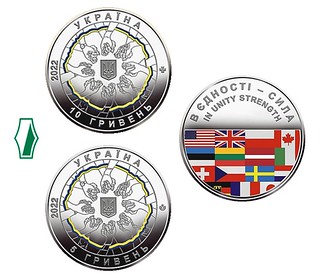 The National Bank of Ukraine has just released its first commemorative coins since the country's invasion by Russian forces on the 24th February. Since this day, the nation and its people have been staunchly defending their homeland and repelling the deadly, destructive aggression brought to their country by the president and government in the Kremlin. In support of Ukraine's defence of their territory, numerous countries have come to their aid with funds, weapons, military advisors, humanitarian assistance, and moral support, especially to Volodymyr Zelenskyy, president of Ukraine since 2019.
The National Bank of Ukraine has just released its first commemorative coins since the country's invasion by Russian forces on the 24th February. Since this day, the nation and its people have been staunchly defending their homeland and repelling the deadly, destructive aggression brought to their country by the president and government in the Kremlin. In support of Ukraine's defence of their territory, numerous countries have come to their aid with funds, weapons, military advisors, humanitarian assistance, and moral support, especially to Volodymyr Zelenskyy, president of Ukraine since 2019.
During a short ceremony at the National Bank, a silver coin was presented to representatives from the embassies of France, Japan, the Netherlands, the United Kingdom, Canada, Germany, Estonia, Latvia, Sweden, the United States, the Czech Republic, and Poland, each country noted on the commemorative coin. The meeting was overseen by Deputy National Bank Governor Oleksiy Shaban and Ukraine's First Deputy Foreign Minister Emine Dzhaparova.
As a testament that Ukrainians are stoically trying to lead their lives in the face of approaching Russian soldiers entering the capital city, it was reported by national media that by 9:00 am on the morning of the 14th July, a crowd of about 80 people had already gathered outside the branch of one bank in Kyiv to purchase the coin. Currently, only a few branches of commercial banks were able to offer the coins as the National Bank's online coin portal has been offline. However, the queue was interrupted by an air raid siren which closed the branch business for some time. Since the start of the war, there has been a huge demand for all things patriotic, and many Ukrainians have commented these eye-catching coins certainly fit the bill.
These commemorative coins ‘In Unity, Strength' begins a new series entitled My Immortal Ukraine and are the first coins to be issued into circulation by the National Bank of Ukraine during wartime. From concept, production and issue, these coins were created in a time of war, literally to the sound of air raid sirens outside the walls of the National Bank.
To read the complete article, see:
Ukraine: First commemorative coins released since invasion salutes world friends in support of democracy
(https://world.mintnewsblog.com/2022/07/ukraine-first-commemorative-coins-released-since-invasion-salutes-world-friends-in-support-of-democracy/)
FRASER'S FLIP AND MODERN LOGO DESIGN
The portrait change on the 2022 U.S. quarters parallels a shift in the design of corporate logos, according to this Fast Company article. -Editor
One change to the U.S. quarter this year has gone mostly unnoticed. The portrait of George Washington on the coin, which had faced left since its first appearance in 1932, flipped to face right in 2022. Based on internet chatter, the recent barely-perceptible tweak to Instagram's logo attracted much more attention. But the about-face on the quarter reflects a large trend in American logo design over the past century.
The new portrayal of Washington is a design by American sculptor Laura Gardin Fraser that had been recommended in 1931 to adorn the coin, but was snubbed in favor of John Flanagan's left-facing offering. Somewhat ironically, Fraser's Washington appears more masculine and less fussy than Flanagan's.
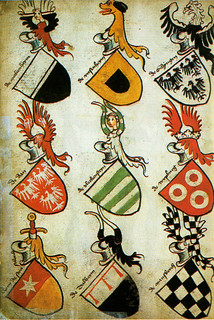 Going left used to be the norm—on currency and on corporate logos. In the early 20th century, as marketing and branding began their development, the design of many logos was based in the centuries-old traditions of heraldry. One of these was that figures on a heraldic shield should face the viewer's left, because that was the shield-bearer's right, and it was his perspective, not the eye of the beholder, that mattered.
Going left used to be the norm—on currency and on corporate logos. In the early 20th century, as marketing and branding began their development, the design of many logos was based in the centuries-old traditions of heraldry. One of these was that figures on a heraldic shield should face the viewer's left, because that was the shield-bearer's right, and it was his perspective, not the eye of the beholder, that mattered.
These ancient heraldic rules tripped up some American companies. In 1925, Graybar Electric, a Midwestern company that sells telecommunications equipment, discovered to its horror that the line on its shield logo was tilted the wrong way, making it a bar sinister,
or symbol of illegitimacy, in the language of heraldry. It quickly changed its logo.
But over the years, right-facing marks have won out. By 1960, a survey conducted by the Opinion Research Corporation showed that Americans overwhelmingly viewed rightward logos more positively than their opposites. Perhaps it's only natural in a culture where we read from left to right, but logos facing right were also seen as moving forward.
By 1978, corporate identity legend Wally Olins was bemoaning the cliché of logos ending with an arrow, preferably pointing upwards and slightly to the right, indicative of Progress, Dynamism and a controlled but powerful thrust towards what is clearly a Better and Brighter Future.
(And this was well before Amazon‘s smile logo and Target's Up & Up brand.) No one cared that these marks were all bar sinister.
Unlike the shields of heraldry, companies also placed emphasis on how logos appeared to the viewer, rather than the user. For instance, Apple discovered that while its logo on its laptops would face the user when they opened the computer, it would then appear upside-down to onlookers. So, the company subsequently flipped the symbol.
Today, there are some notable logos, particularly those depicting birds, that still uphold the heraldic leftward tradition: Lufthansa, Tottenham Hotspur, Japan Airlines, the Philadelphia Eagles (the only left-facing National Football League symbol).
But in general, right-facing logos now predominate. Of the 62 Fortune 500 logos that can be said to be facing or moving laterally, 82% go right. It's the left-facing exceptions that are interesting. Some, like Goodyear and John Deere, have been leftward for over a century. But others, like Aflac's duck and building materials supplier Builders Firstsource's leaning 1,
are more recent and seem to represent a design zag rarely taken.
To read the complete article, see:
How a small change to U.S. quarters is part of a big trend in logo design
(https://www.fastcompany.com/90769829/us-quarter-flip-2022-logo-design-trends)
To read earlier E-Sylum articles, see:
FRASER'S WASHINGTON TURNS BACK ON GOD!
(https://www.coinbooks.org/v25/esylum_v25n22a26.html)
NOTES FROM E-SYLUM READERS: JUNE 5, 2022 : George and God
(https://www.coinbooks.org/v25/esylum_v25n23a13.html)
FOR EDEL DAAD: THE NOVEL DEEDS MEDAL
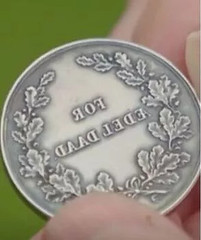
An article published by the Express on July 17th caught my eye this week with an odd illustration of a medal. A search for more information turned up a Februrary 18, 2021 article by The Sun on the same topic with a more sensible illustration. Here's an excerpt from the better Sun article. -Editor
The proud owner of the token of bravery was clearly emotional as he heard what military specialist Mark Smith had to say.
Examining the artefact, which had the words 'for edel daad' written on it, Mark told the guest it was from the "Swedish-Norwegian royal family when they were joined together."
"It's called the noble deeds medal and it was given out for saving life at sea, usually it was for ship wrecks."
Appearing on the BBC show, the owner explained the back story and said: "I found out it was my great great grandfather's who was actually 14 at the time.
"He was a member of the lifeboat crew and they went out to rescue 20 men off the coast of north Wales - 1889, 6th and 7th of October, there was a massive storm."
Mark added that it was likely to have been a Swedish vessel that had gone into the rocks.
When it came to the all important evaluation, Mark told the family: "Today, it's actually worth £700."
Clearly surprised by the amount, the guest quickly responded: "Good grief, worth more than that to us."
A somewhat similar medal was sold in a 2012 Künker sale. -Editor
To read the complete lot description, see:
Medaille für die edle Tat [Medaljen for Ædel Daad]
(https://www.numisbids.com/n.php?p=lot&sid=307&lot=9202)
To read the complete articles, see:
PRICELESS Antiques Roadshow guest takes swipe at expert as he insists medal is ‘worth more' than valuation
(https://www.the-sun.com/entertainment/tv/2357890/antiques-roadshow-guest-insists-medal-worth-more/)
Antiques Roadshow guest gobsmacked by value of grandfather's medal for lifesaving rescue
(https://www.express.co.uk/showbiz/tv-radio/1641779/antiques-roadshow-medal-valuation-700-pounds)
THE BOOK BAZARRE
LOOSE CHANGE: JULY 24, 2022
Here are some additional items in the media this week that may be of interest. -Editor
A Coin World article by Arthur L. Friedberg discusses Poland's new 10-zloty note. -Editor
It issued a new commemorative legal tender 20-zloty bank note ($4.22 U.S.) on July 19 with a theme called Protection of Poland's Eastern Border.
It was made available for 130 zlotych each at 16 regional branches of the national bank and at its online store collector.nbp.pl. The issue limit was set at 80,000 pieces.
The note comes in a folder including text that pulls no punches. It denigrates the Russian Federation's attempts at dominance and the Putin regime's actions aimed at trying to rebuild the Soviet post-World War II empire. It also accuses Belarus and its dictator Alexander Lukashenko of using Belarus as a center of migration pressure by intentionally bringing migrants, mainly from Muslim countries and wanting to go to Western Europe, right up to the Polish border.
To read the complete article, see:
Polish 10-zloty note protests Russian acts of aggression
(https://www.coinworld.com/news/paper-money/polish-10-zloty-note-protests-russian-acts-of-aggression)
For more information, or to order, see:
20ZL PROTECTION OF THE POLISH EASTERN BORDER - BANKNOT
(https://www.redisbad.pl/en_US/p/20zl-Protection-of-the-Polish-Eastern-Border-banknot/2350)
What can be given, can be taken away (and vice versa), even after a century. Last week we discussed the reinstatement of Jim Thorpe's 1912 Olympic Gold medals; this week there's talk of rescinding Medals of Honor for soldiers from the infamous 1890 Wounded Knee massacre. -Editor
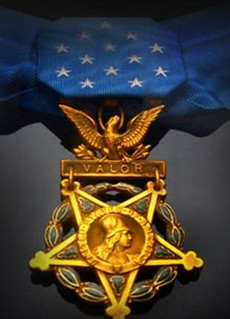 Lawmakers in the House of Representatives have made a move to posthumously rescind Medals of Honor awarded to U.S. soldiers who participated in the infamous 1890 Wounded Knee massacre, where an estimated 250 Native Americans — mostly women and children — were killed.
Lawmakers in the House of Representatives have made a move to posthumously rescind Medals of Honor awarded to U.S. soldiers who participated in the infamous 1890 Wounded Knee massacre, where an estimated 250 Native Americans — mostly women and children — were killed.
Legislation to take back the medals — the nation's highest award for valor — was passed last week as an amendment to the fiscal 2023 defense policy bill, Army Times reported.
While similar attempts have been made in the past, they were ultimately set aside during compromises between the House and Senate versions of the bill, according to the report.
To read the complete article, see:
Lawmakers seek to rescind Medals of Honor from soldiers who carried out Wounded Knee massacre
(https://www.foxnews.com/us/lawmakers-seek-rescind-medals-honor-soldiers-carried-wounded-knee-massacre)
To read the earlier E-Sylum article, see:
LOOSE CHANGE: JULY 17, 2022 : Jim Thorpe 1912 Olympic Gold Medals Reinstated
(https://www.coinbooks.org/v25/esylum_v25n29a28.html)

